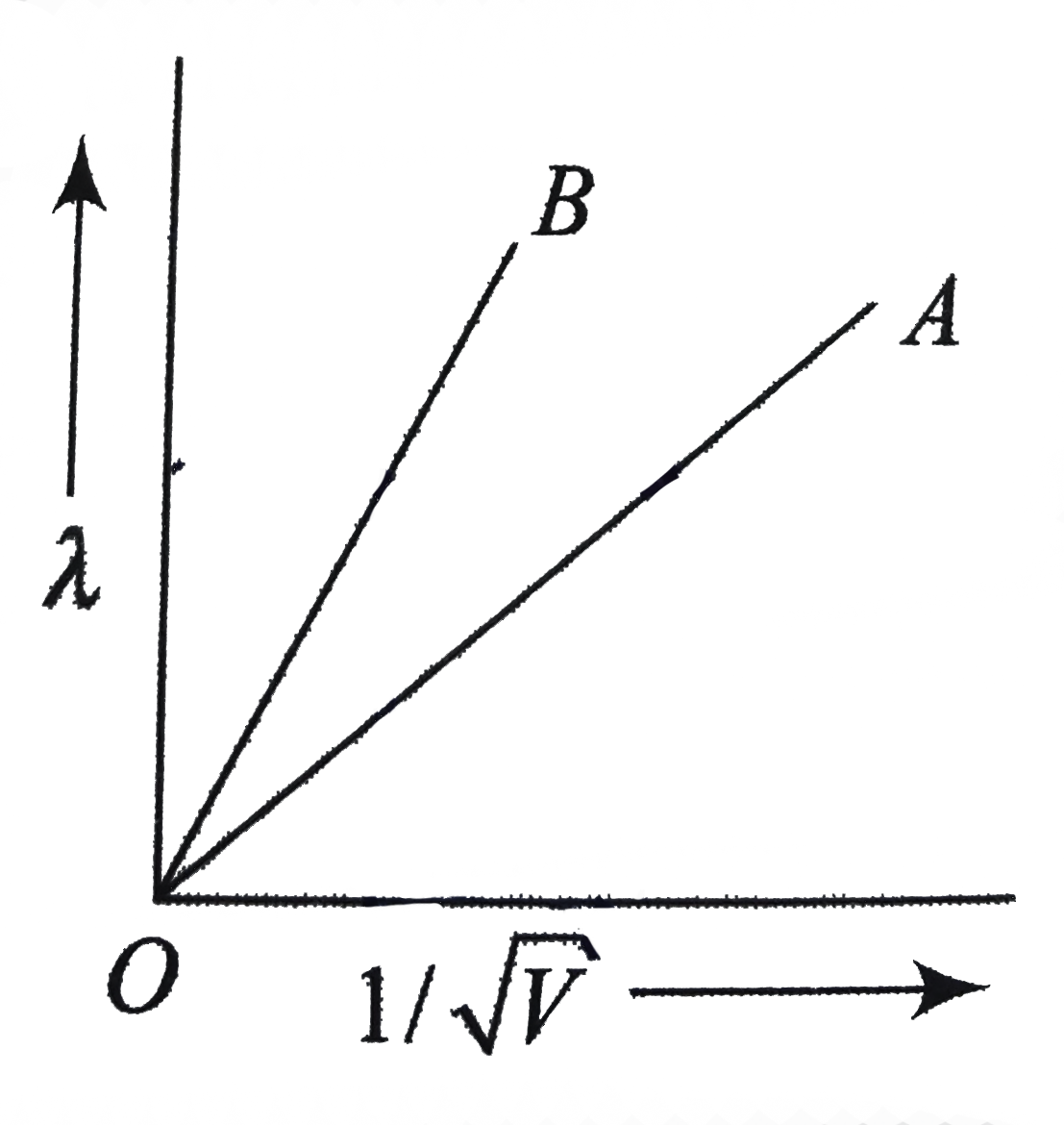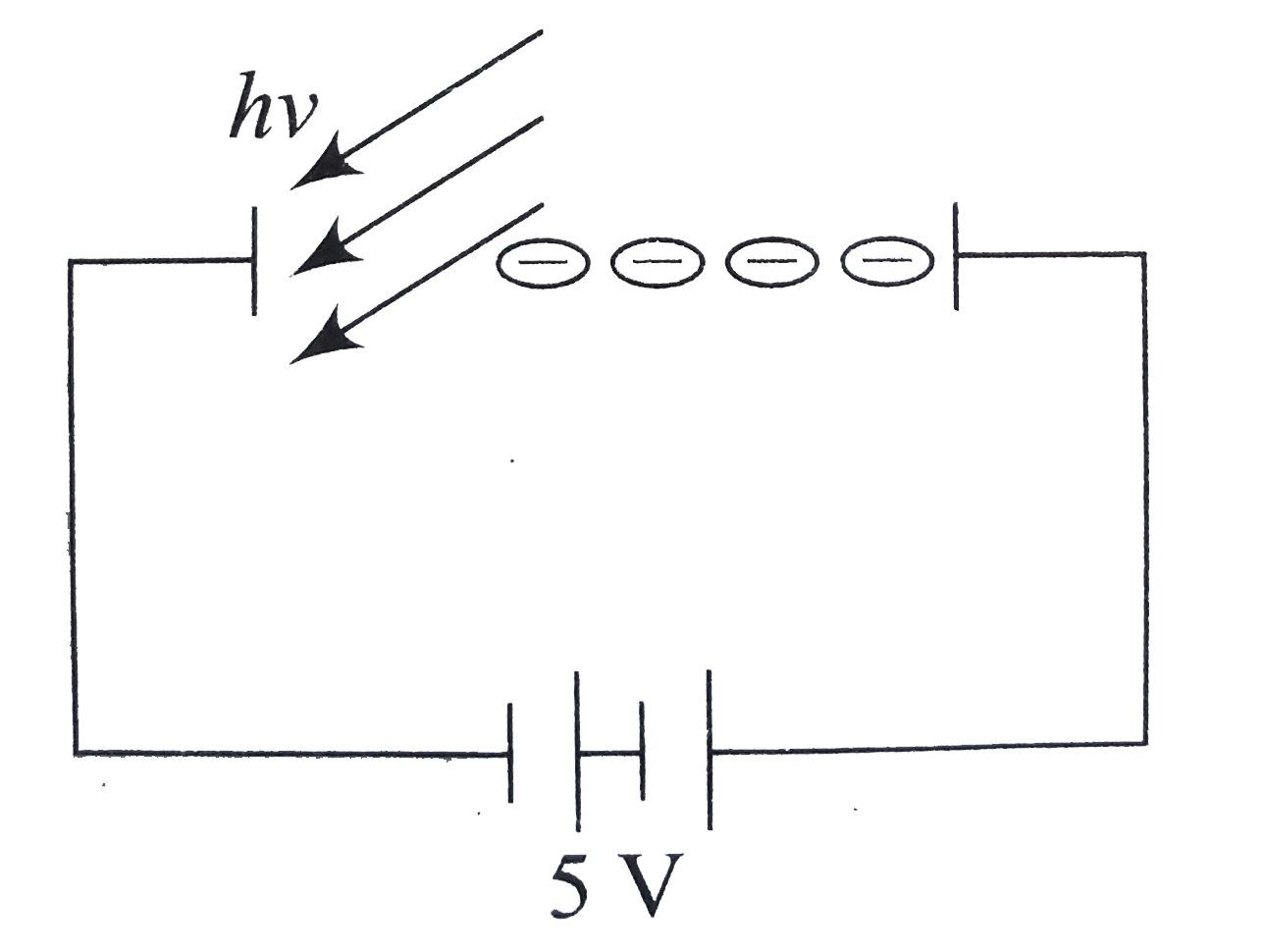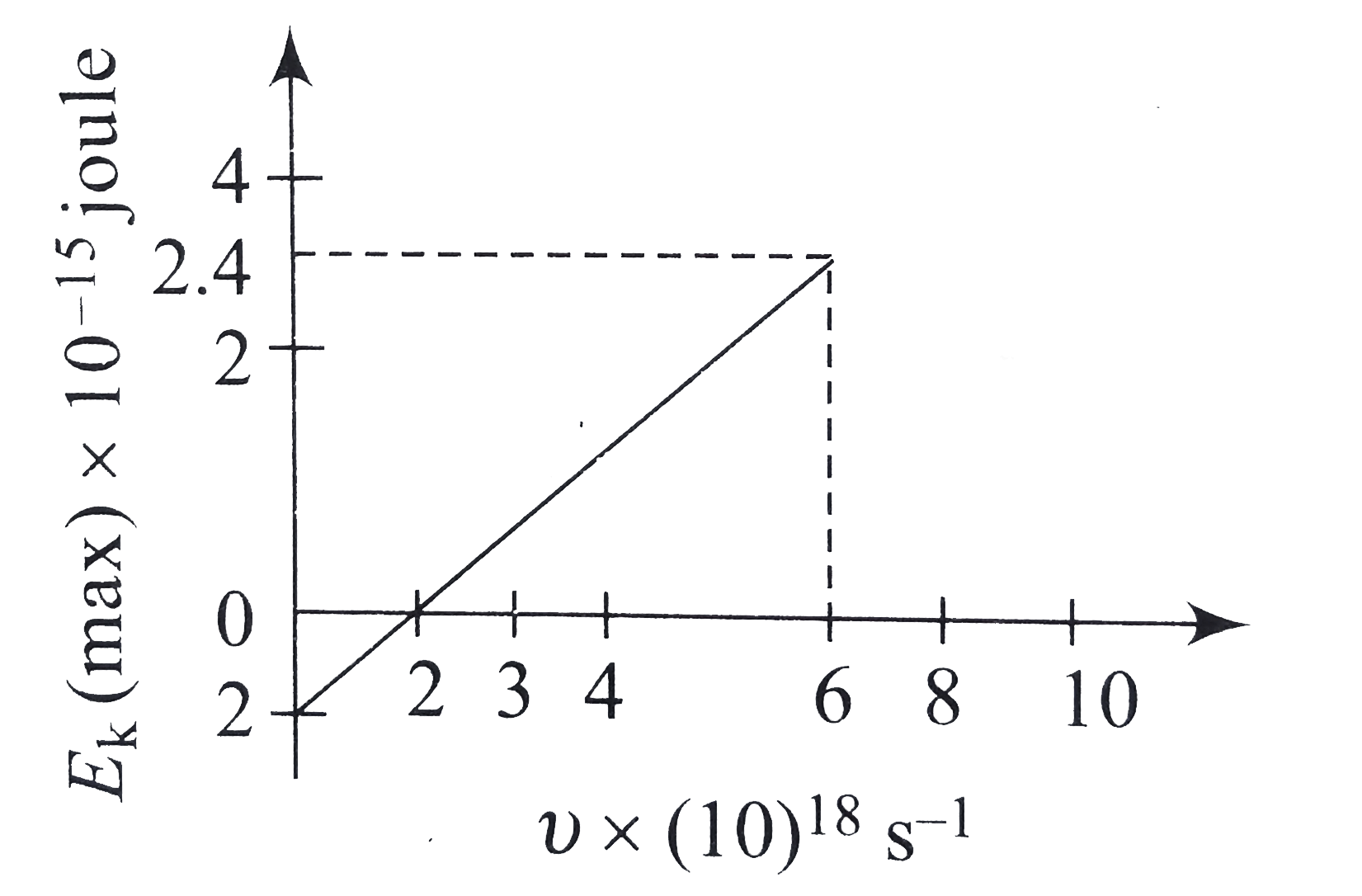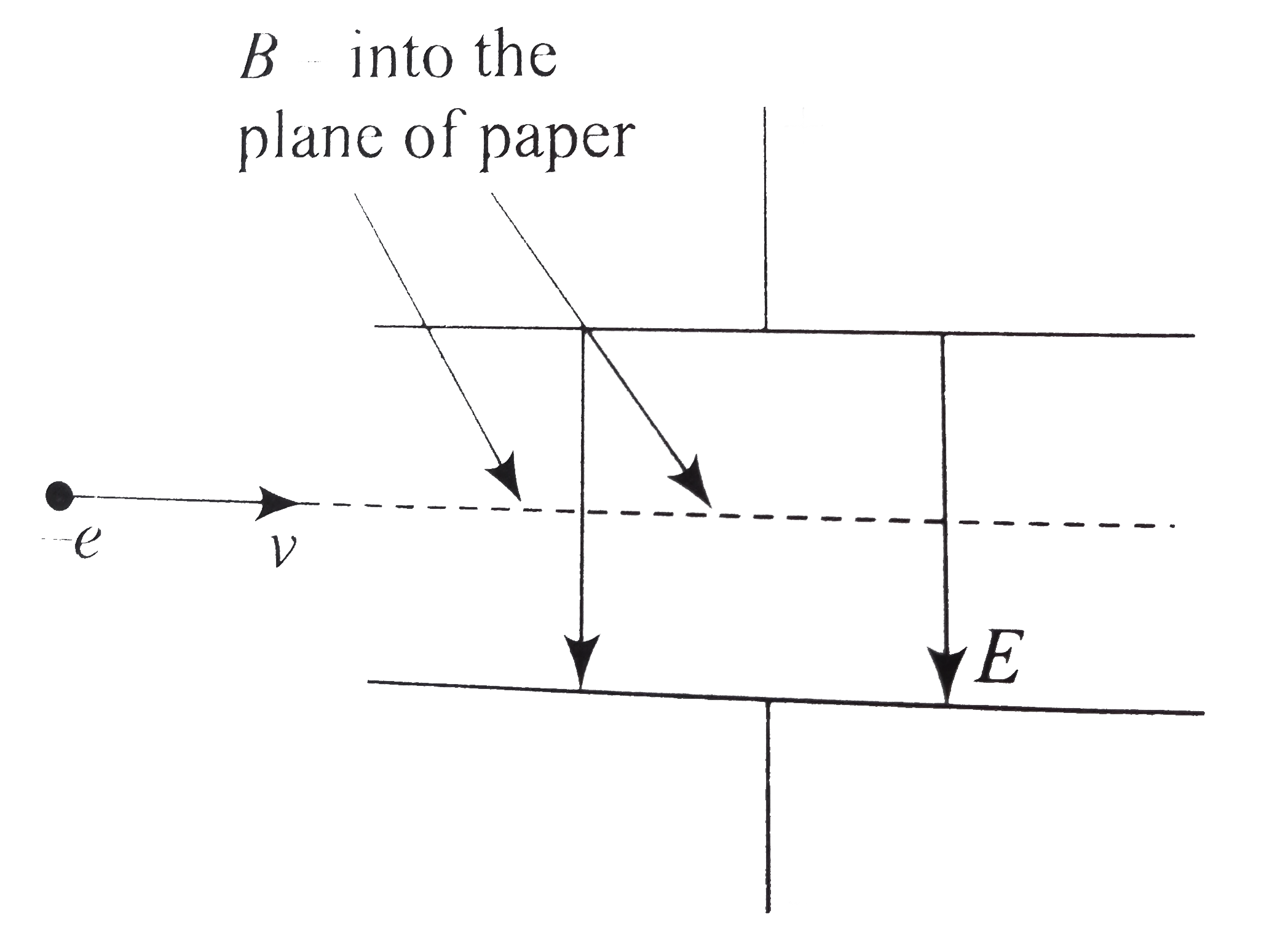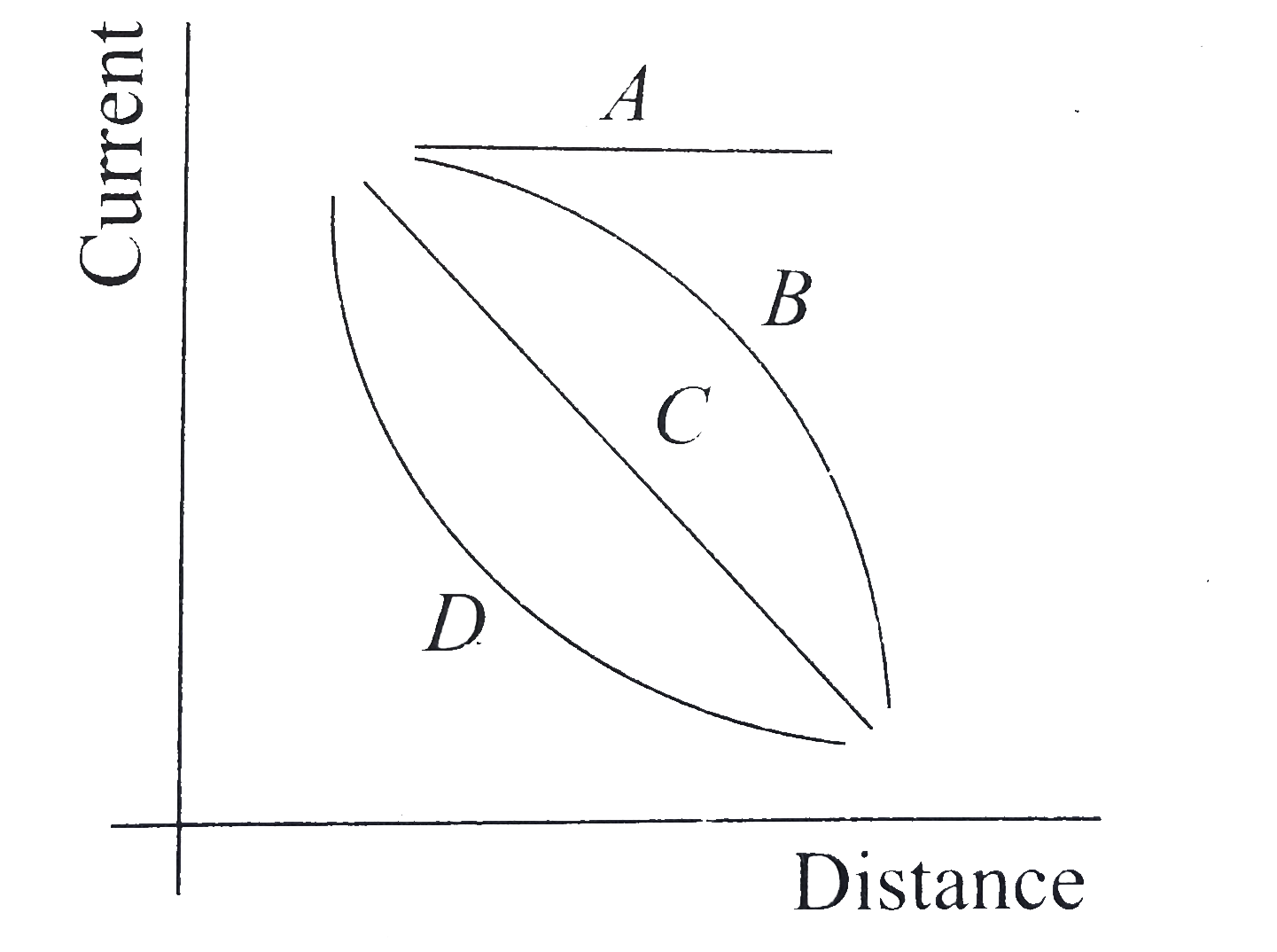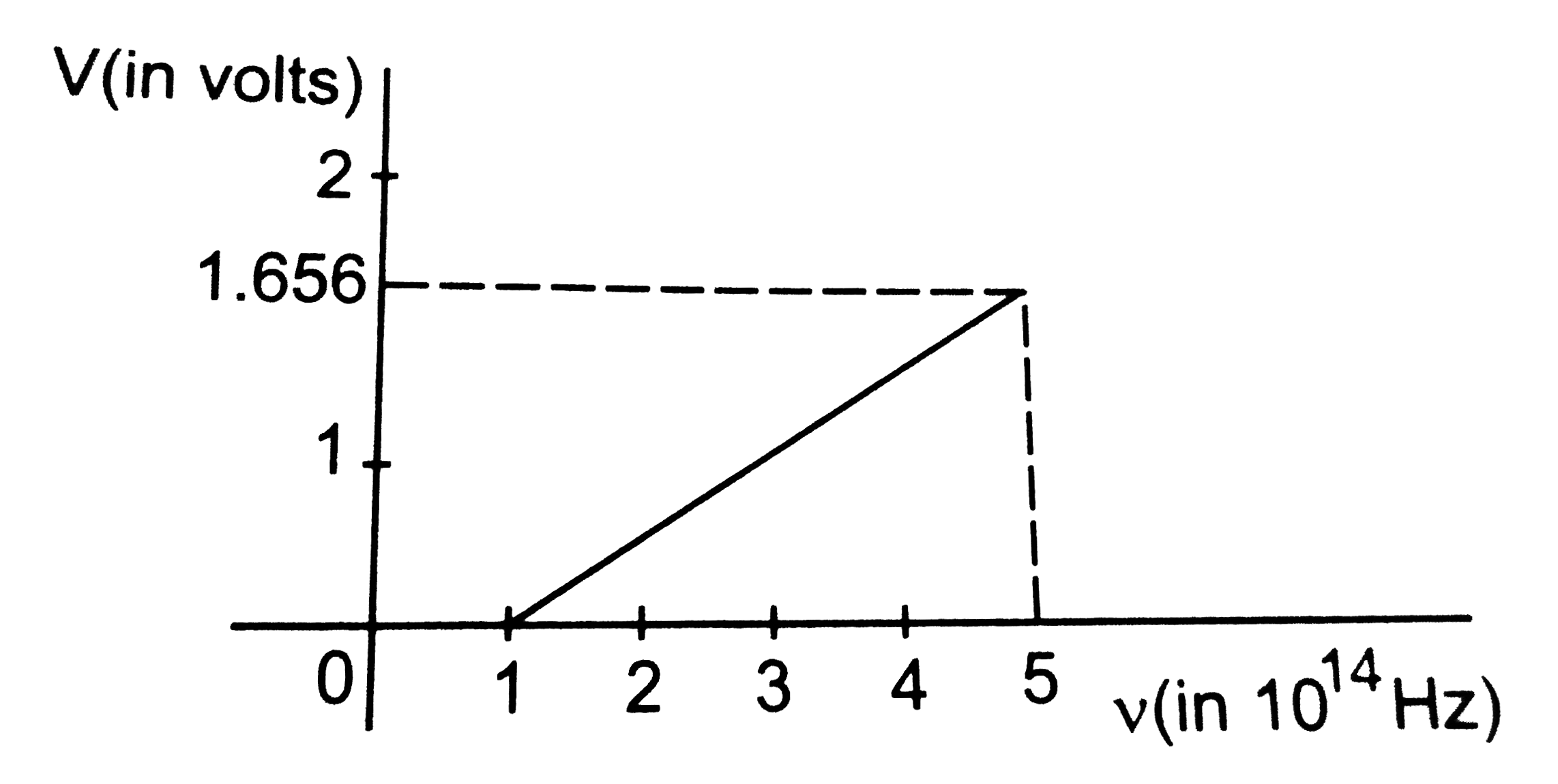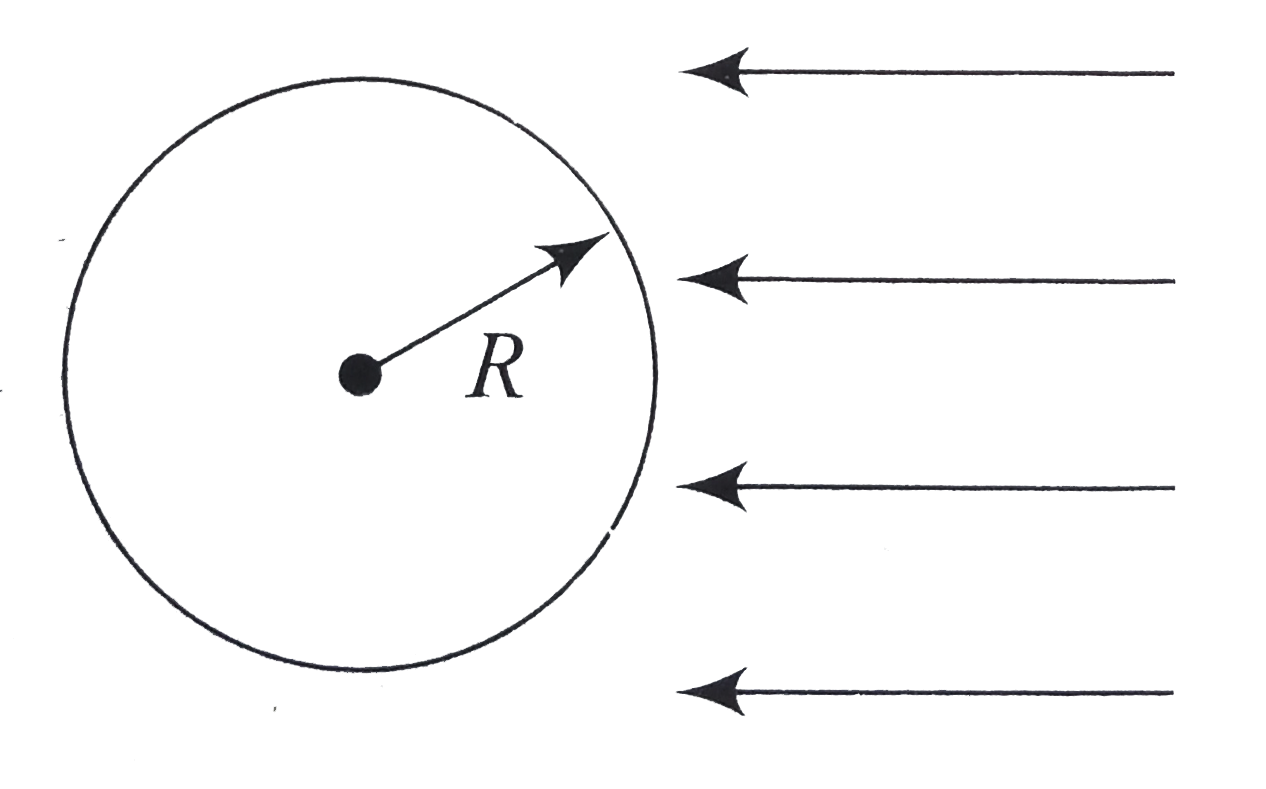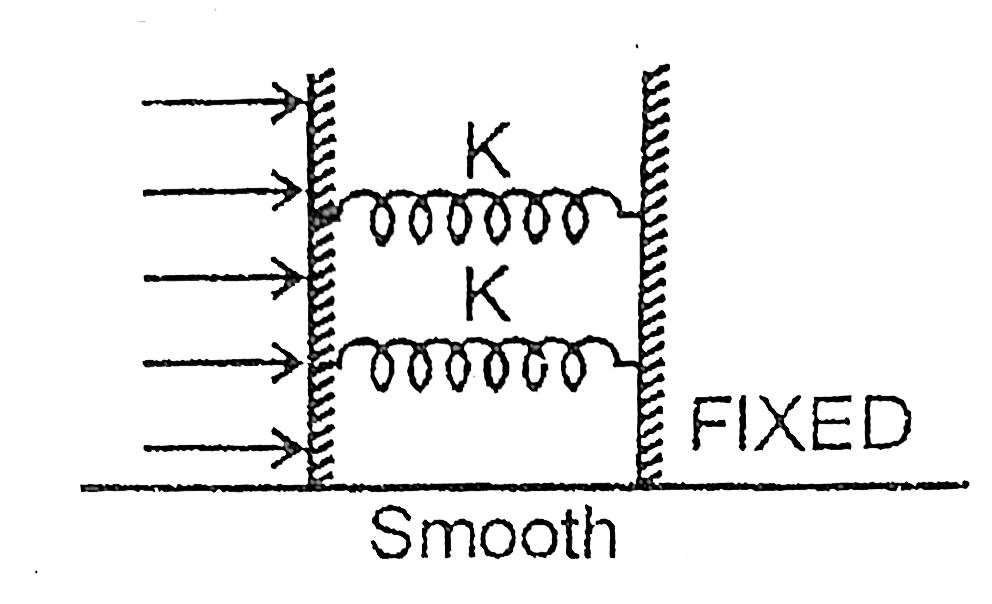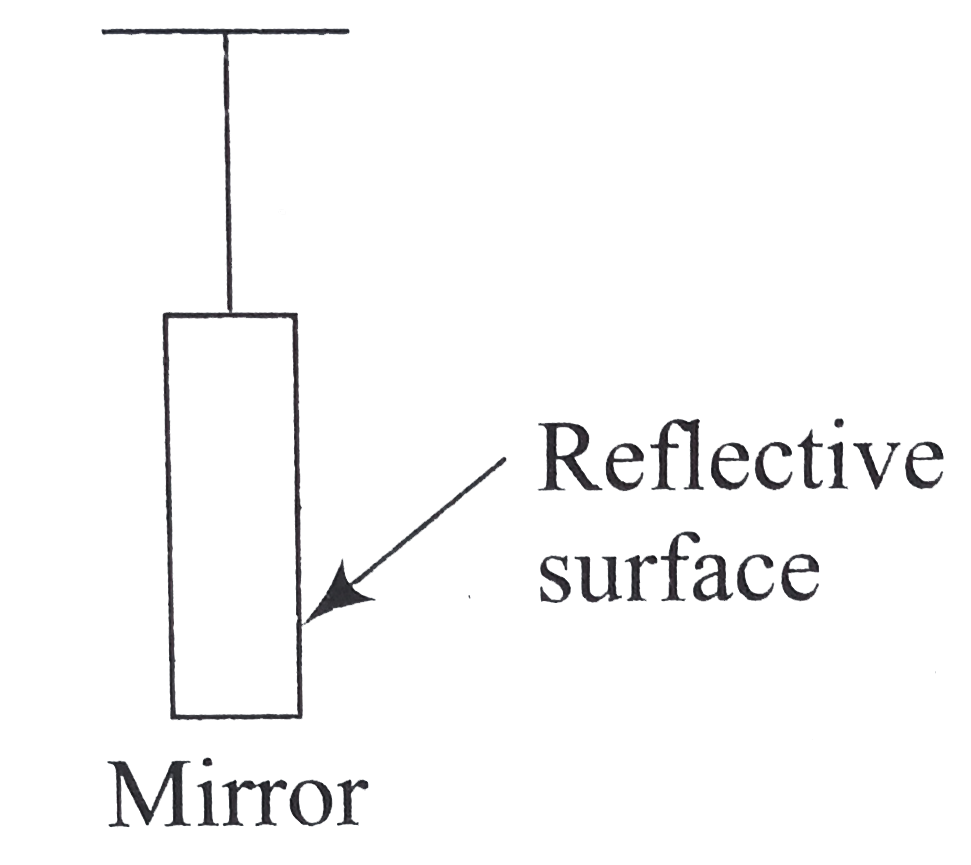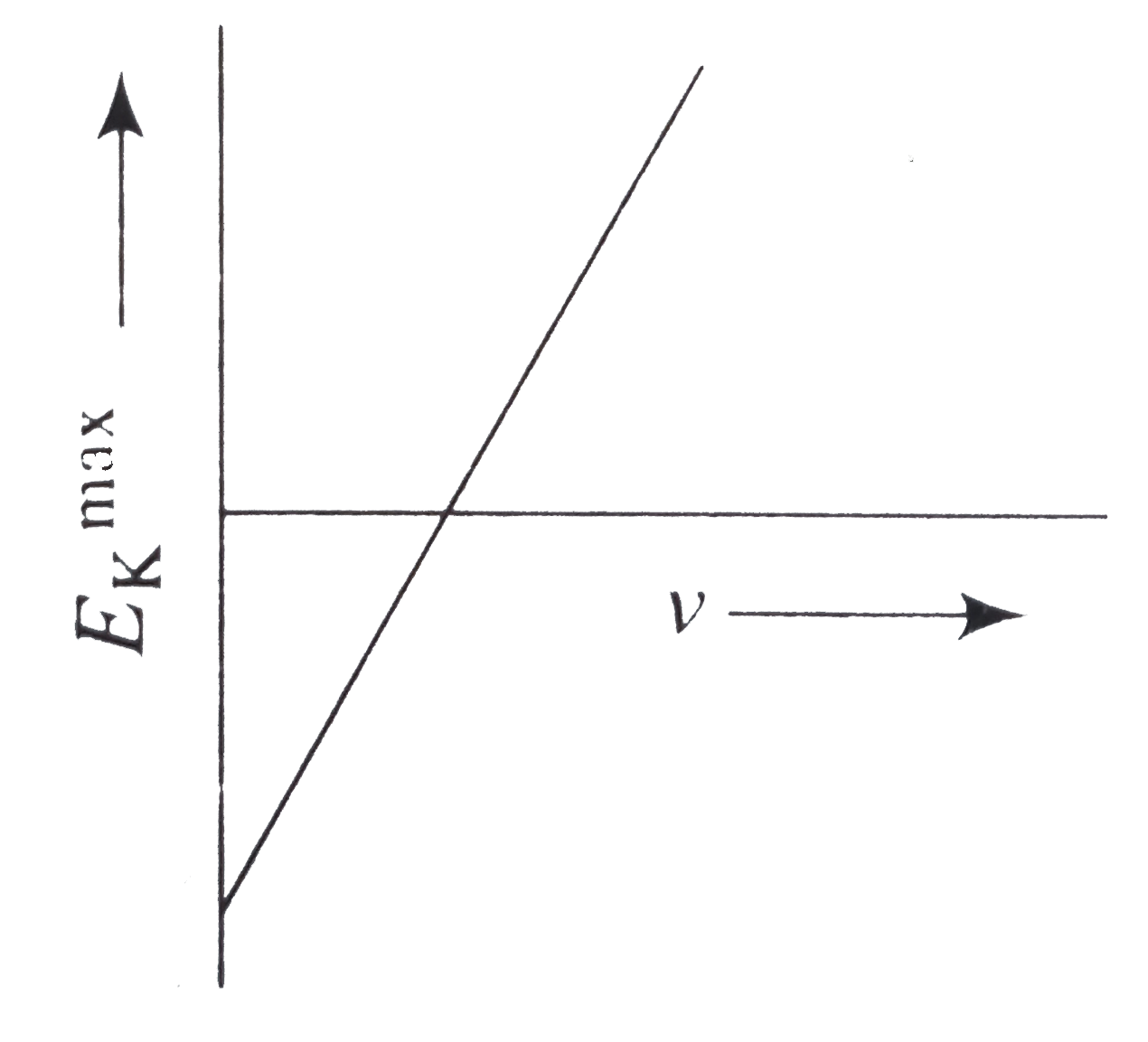Multiple Correct from CENGAGE PHYSICS (ENGLISH) PHOTOELECTRIC EFFECT for Class 12
| Class 12 | PHYSICS |
| Chapter | PHOTOELECTRIC EFFECT |
| CENGAGE PHYSICS (ENGLISH) | Multiple Correct |
| Medium | English |
| Academic Year | 2023-2024 |
Question 17
The work function for the following metals is given: Na: 2.75 eV, K: 2.30 eV, Mo: 4.17 eV, Ni: 5.15 eV. Which of these metals will not give photoelectric emission for a radiation of wavelength 3300 Å from a He-Cd laser placed 1 m away from the photocell? What happens if the laser is brought nearer and placed 50 cm away?View SolutionQuestion 20
The maximum KE of photoelectrons emitted from a cetain metallic surface is 30 eV when monochromatic radiation of wavelength λ falls on it. When the same surface is illuminated with light of wavelength 2λ, the minimum KE of photoelectrons is found to be 10 eV. (a) Calculate the wavelength λ and (b) determine the maximum wavelength of incident radiation for which photoelectric emission is possible.View SolutionQuestion 23
A uniform monochromatic beam of light of wavelength 365×10−9m and intensity 10−8Wm−2 falls on a surface having absorption coefficient 0.8 and work function 1.6 eV. Determine the number of electrons emitted per square metre per second, power absorbed per m2, and the maximum kinetic energy of emitted photo electrons.View SolutionQuestion 24
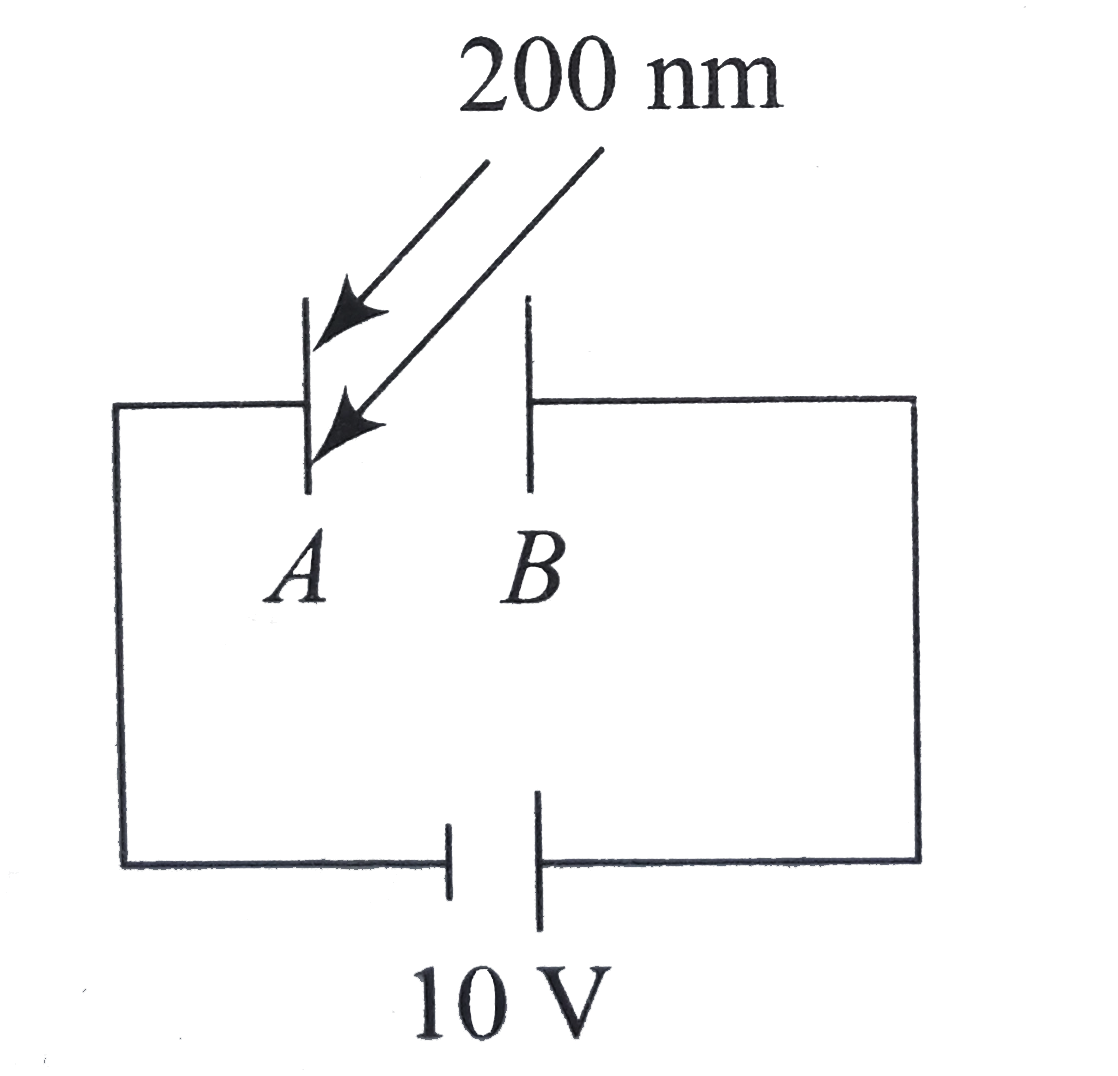
In Fig. electromagnetic radiations of wavelength 200nm are incident on a metallic plate A. the photoelectrons are accelerated by a potential difference of 10 V. These electrons strike another metal plate B from which electromagnetic radiations are emitted. The minimum wavelength of emitted photons is 100nm. If the work function of metal A is found to be (×x10−1)ev, then find the value of x. (Given hc=1240eV nm) View SolutionQuestion 25
The path of photoelectrons emitted due to electromagnetic radiation incident on a sample of material A, is found to have a maximum bending radius of 0.1 m in a magnetic field of (√23)×10−4T. When the radiation is incident normally on a double slit having a slit separation of 0.1mm, it is observed that there are 10 fringes in a width of 3.1 cm on a screen placed at a distance of 1 m from the double slit. Find the work function of the material. and the corresponding threshold wavelength. What sould be the wavelength of the incident light so that the bending radius is one-half of what it was before? Given that mass of the electron=0.5MeVc2,hc=12400eV−AView SolutionQuestion 28
Light of wavelength 180 nm ejects photoelectrons from a plate of metal whose work - function is 2 eV. If a uniform magnetic field of 5×10−5 T be applied parallel to the plate, what would be the radius of the path followed by electrons ejected normally from the plate with maximum energy.View SolutionQuestion 29
When a surface is irradiated with light of wavelength 4950A, a photocurrent appears which vanishes if a retarding potential greater than 0.6V is applied across the photo tube. When a different source of light is used, it is found that the critical retarding potential is changed to 1.1V. Find the work function of the emitting surface and the wavelength of the second source.View SolutionQuestion 31
A vacuum photocell consists of a central cathode and an anode. The internal surface is silver of work function 4.5 eV. The contact potential difference between the electrodes equals to 0.6 V. The photocell is illuminated by light of wavelength 2.3×10−7m.
a. What retrading potential difference should be applied between electrodes of the photocell for the photocurrent to drop to zero?
b. If a retarding potential of 1V is applied between electrodes at what limiting wavelength λ of light incident on the cathode will on the cathode will the photoelectric effect begin?View SolutionQuestion 32
The rediation emitted when an electron jumps from n=3→n=2 orbit in a hydrogen atom falls on a metal to produce photoelectron. The electron from the metal surface with maximum kinetic energy are made to move perpendicular to a magnetic field of (1/320)T in a radius of 10−3m. Find (a) the kinetic energy of the electrons, (b) Work function of the metal , and (c) wavelength of radiation.View SolutionQuestion 33
A parellel beam of monochromatic light of wavelength 500 nm is incident normally on a perfectly absorbing surface. The power through any cross section of the beam is 10 W. Find
(a) the number of photons absorbed per second by the surface and
(b) the force exerted by the light beam on the surface.View SolutionQuestion 34
A uniform monochromatic beam of light of wavelength 365×10−9m and intensity 10−8Wm−2 falls on a surface having absorption coefficient 0.8 and work function 1.6 eV. Determine the number of electrons emitted per square metre per second, power absorbed per m2, and the maximum kinetic energy of emitted photo electrons.View SolutionQuestion 36
What amount of energy sould be added to an electron to reduce its de Broglie wavelength λ1=550nm incident on it, causing the ejection of photoelectrons for which the stopping potential is Vs1=0.19V. If the radiation of wavelength λ2=190nm is now incident on the surface, (a) calculate the stopping potential VS2, (b) the work function of the surface, and (c) the threshold frequency for the surface.View SolutionQuestion 37
What amount of energy should be added to an electron to reduce its de Broglie wavelength λ1=550nm incident on it, causing the ejection of photo-electrons for which the stopping potential is Vs1=0.19V. If the radiation of wavelength λ2=190nm is now incident on the surface, (a) calculate the stopping potential VS2, (b) the work function of the surface, and (c) the threshold frequency for the surface.View SolutionQuestion 38
A cylindrical rod of some laser material 5×10−2m long and 10−2m in diameter contains 2×1025 ions per m3. If on excitation all the ions are in the upper energy level and de-excite simultaneously emitting photons in the same direction , calculate the maximum energy contained in a polse of radiation of wavlength 6.6×10−7m. If the pulse lasts for 10−7s, calculate the average power of the laser during the pulse.View SolutionQuestion 39
A 100 W sodium lamp is radiating light of wavelength 5890A, uniformly in all directions,
a. At what rate, photons are emitted from the lamp?
b. At what distance from the lamp, the average flux is 1 photon(cm2−s)−1?
c. What are the photon flux and photon density at 2m from the lamp?View SolutionQuestion 43
A certain metallic surface is illuminated with monochromatic light of wavelength λ. The stopping potential for photoelectric current for this light is 3V∘. If the same surface is illuminated with light of wavelength 2λ, the stopping potential is V0. The threshold wavelength for this surface for photoelectric effiect is View SolutionQuestion 46
Light of wavelength 0.6 μm from a sodium lamp falls on a photocell and causes, the emission of photoelectrons for which the stopping potential is 0.5 V. With light of wavelength 0.4 μm from a sodium lamp, stopping potential is 1.5V. With this data, the value of h/e is (n×10−15) Vs. Find value of n.View SolutionQuestion 47
Ultraviolet light of wavelength 300nm and intensity 1.0Wm−2 falls on the surface of a photosensitive material. If one per cent of the incident photons produce photoelectrons, then the number of photoelectrons emitted per second from an area of 1.0 cm2 of the surface is nearlyView SolutionQuestion 61
In an experiment on the photoelectric effect, an evecuated photocell with a pure metal cothode is used. Which graph best represents the variation of B, the minimum potential defference needed to prevent current from flowing, when x, the frequency of the incident light, is varied?View SolutionQuestion 62

A metal surface in an evacuated tube is illuminated with monochromatic light causing the emission of photoelectrons. For a given intensity of light, a graph between saturation current and potential of the electrode is given in Fig. If the experiment were repeated with light of twice the intensity but the same wavelength, which of the graphs below would best represent the new relation between I and V?(Dotted represents initial condition)View SolutionQuestion 79
In a series of photoelectric emission experiments on a certain metal surface, possible relationships between the following quantities were investigated: threshold frequency f0, frequency of incident light f, light intensity P, photocurrent I, maximum kinetic energy of photoelectrons Tmax. Two of these quantities, when plotted as a graph of y against x, give a straight line through the origin. Which of the following correctly identifies x and y with the photoelectric quantities ?View SolutionQuestion 87

A photoelectric cell is connected to a source of variable potential difference, connected across it and the photoelectric current resulting (μA) is plotted against the applied potential difference (V). The graph in the broken line represents one for a given frequency and intensity of the incident radiation . If the frequency is increased and the intensity is reduced, which of the following graphs of unbroken line represents the new situation?View SolutionQuestion 90
An image of the sun is formed by a lens, of the focal length of 30 cm, on the metal surface of a photoelectric cell and a photoelectric current I is produced. The lens forming the image is then replaced by another of the same diameter but of focal length 15 cm. The photoelectric current in this case is View SolutionQuestion 96
Silver has a work function of 4.7 eV. When ultraviolet light of wavelength 100 mm is incident upon it, a potential of 7.7 V is required to stop the photoelectrons from reaching the collector plate. How much potential will be required to stop the photoelectrons when light of wavelength 200mm is incident upon silver?View SolutionQuestion 105
In a photoelectric emission, electrons are ejected from metals X and Y by light of frequency f. The potential difference V required to stop the electrons is measured for various frequencies.. If Y has a greater work function than X, which graph illustrates the expected results?View SolutionQuestion 131
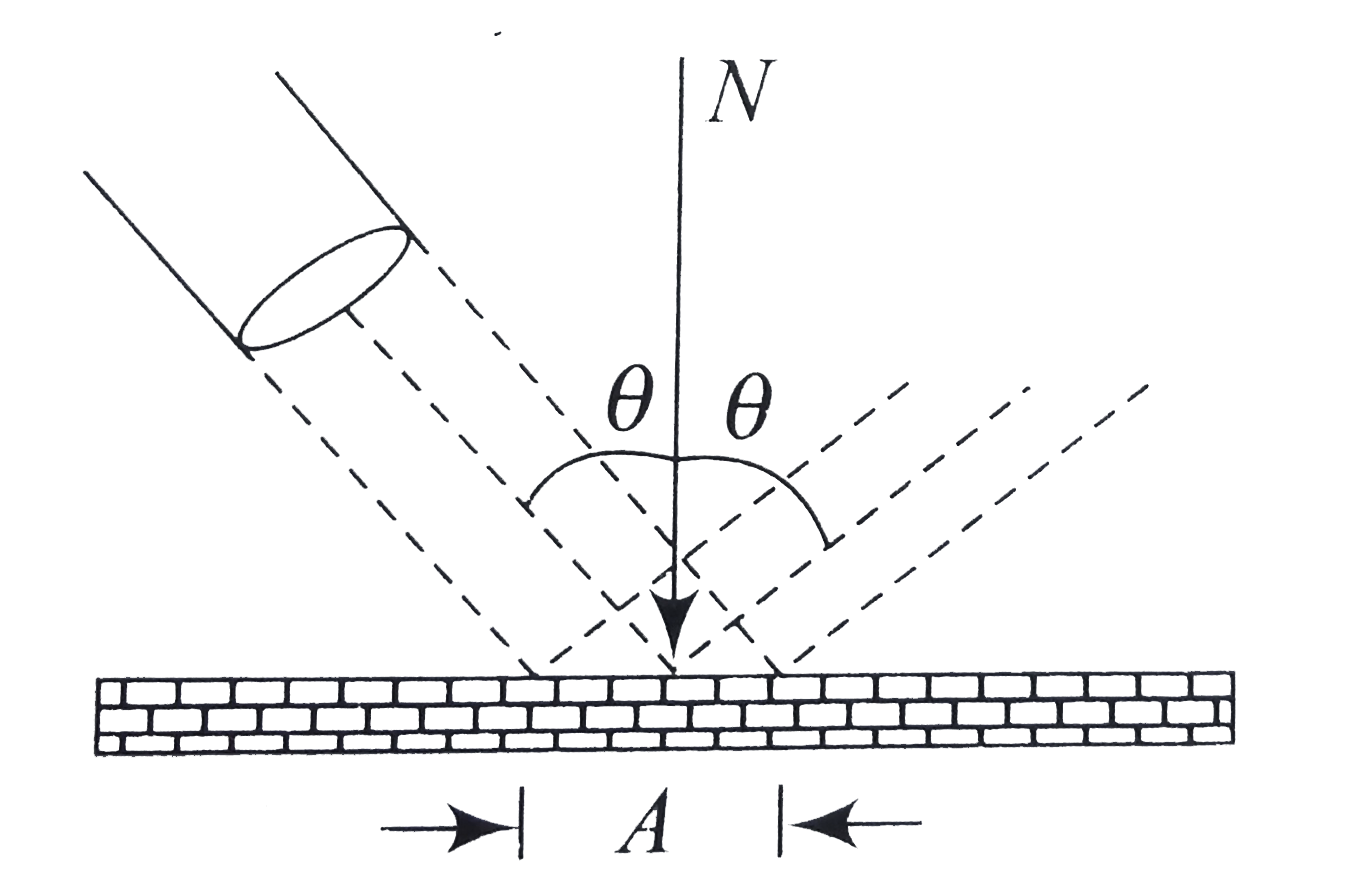
A nozzle throws a stream of gas against a wall with a velocity v much larger than the thermal agitation of the molecules. The wall deflects the molecules without changing the magnitude of their velocity. Also, assume that the force exerted on the wall by the molecules is perpendicular to the wall. (This is not strictly true of a rough wall). Find the force exerted on the wallView SolutionQuestion 134
Light of wavelength λ from a small 0.5 mW He-Ne laser source, used in the school laboratory, shines from a spacecraft of mass 1000 kg. Estimate the time needed for the spacecraft to reach a velocity of 1.0km−1 from rest. The momentum p of a photon of wavelength λ is given by p=hλ, where h is Planck's constant.View SolutionQuestion 144
A photosensitive material is at 9m to the left of the origin and the source of light is at 7 m to the right of the origin along x-axis.The photosensitive material and the source of light start from rest and move, respectively, with 8ˆims−1 and 4ˆims−1. The ratio of intensities at t=0 to t−3s as received by the photosensitive materialView SolutionQuestion 149
Two protons are having same kinetic energy. One proton enters a uniform magnetic field at right angles ot it. Second proton enters a uniform electric field in the direction of field. After some time their de Broglie wavelengths are λ1andλ2 then (a) λ1=λ2 (b) λ1<λ2 (c) λ1>λ2 (d) some more information is required View SolutionQuestion 159
Radiation of wavelength 546 nm falls on a photo cathode and electrons with maximum kinetic energy of 0.18 eV are emitted. When radiation of wavelength 185 nm falls on the same surface, a (negative) stopping potential of 4.6 V has to be applied to the collector cathode to reduce the photoelectric current to zero. Then, the ratio he is View SolutionQuestion 160
The human eye is most sensitive to green light of wavelength 505 nm. Experiments have found tthat when people are kept in a dark room until their eye adapt to the darkness, a single photon of green light will trigger receptor cells in the rods of the retina. The velocity of typical bacterium of mass 9.5×10−12g, if it had absorbed all energy of photon ,is nearlyView SolutionQuestion 171
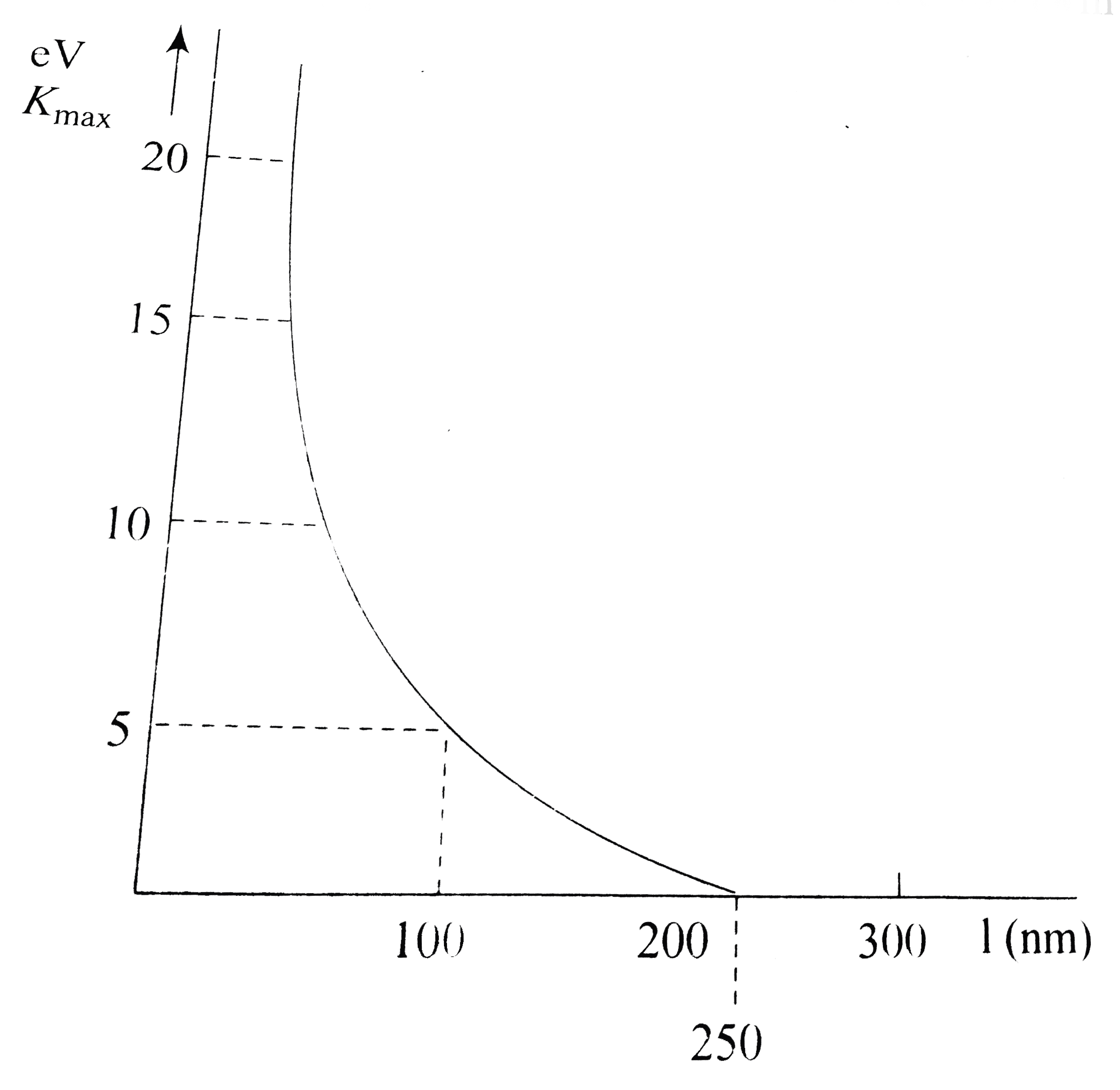
In a photoelectric effect experiment , the maximum kinetic energy of the ejected photoelectrons is measured for various wavelength of the incident light. Figure shows a graph of this maximum kinetic energy Kmax as a function of the wavelength λ of the light falling on the surface of the metal. Which of the following statement/i is/ are correct?View SolutionQuestion 174
Some questions (Assertion-Reason Type) are given below. Each question contains Statement I (Assertion) and statement II(reason). Each question has 4 choices (a),(b),(c ) and (d) out of which only one is correct. So select the correct choise.
a. Statement I is True, Statement II is True,Statement II is a correct explanation for Statement I
b. Statement I is True, Statement II is True, Statement II is NOT a correct ecplanation for Statement I
c. Statement I is True, Statement II is False .
d. Statement I is false, Statement II is True.
Statement:I Though light of a single frequency (monochromatic light) is incident on a metal, the energies of emitted photoelectrons are different.
Statement II: The energy of electrons just after they absorb photons incident on the metal surface may be lost in collision with other atoms in the metal before the electron is ejected out of the metal.View SolutionQuestion 178
Photoelectric threshold of silver is λ=3800A. Ultraviolet light of λ=2600A is incident of a silver surface. Calculate:
a. the value of work function in joule and in eV.
b. maximum kinetic energy of the emitted photoelectrons.
c. the maximum velocity of the photoelectrons.
(Mass of the electrons=9.11×10−31).View SolutionQuestion 182
A metallic surface is illuminated alternatively with light of wavelenghts 3000Å and 6000Å. It is observed that the maximum speeds of the photoelectrons under these illuminations are in the ratio 3 : 1 . Calculate the work function of the metal and the maximum speed of the photoelectrons in two cases.View SolutionQuestion 183
A metallic surface is illuminated alternatively with light of wavelenghts 3000Å and 6000Å. It is observed that the maximum speeds of the photoelectrons under these illuminations are in the ratio 3 : 1 . Calculate the work function of the metal and the maximum speed of the photoelectrons in two cases.View SolutionQuestion 189
In a photoelectric effect experimetent, a metallic surface of work function 2.2 eV is illuminated with a light of wavelenght 400 nm. Assume that an electron makes two collisions before being emitted and in each collision 10% additional energy is lost.
Q. Find the kinetic energy of this electron as it comes out of the metal.View SolutionQuestion 190
A light beam of wavelength 400nm is incident on a metal of work- function 2.2eV. A particular electron absorbs a photon and makes 2 collisions before coming out of the metal
(a) Assuming that 10% of existing energy is lost to the metal in each collision find the final kinetic energy of this electron as it comes out of the metal.
(b) Under the same assumptions find the maximum number of collisions, the electron should suffer before it becomes unable to come out of the metal.View SolutionQuestion 191
in an experimental set up to study the photoelectric effect a point source of light of power 3.2×10−3 W was taken. The source can emit mono energetic photons of energy 5eV and is located at a distance of 0.8 m from the center of a stationary metallic sphere of work-function 3.0 eV. The radius of the sphere is r=8×10−3 m. The efficiency of photoelectric emission is one for every 106 incident photons. Based on the information given above answer the questions given below. (Assume that the sphere is isolated and photoelectrons are instantly swept away after the emission).
Time after which photoelectric emission stops isView SolutionQuestion 192
in an experimental set up to study the photoelectric effect a point source of light of power 3.2×10−3 W was taken. The source can emit mono energetic photons of energy 5eV and is located at a distance of 0.8 m from the center of a stationary metallic sphere of work-function 3.0 eV. The radius of the sphere is r=8×10−3 m. The efficiency of photoelectric emission is one for every 106 incident photons. Based on the information given above answer the questions given below. (Assume that the sphere is isolated and photoelectrons are instantly swept away after the emission).
Time after which photoelectric emission stops isView SolutionQuestion 193
in an experimental set up to study the photoelectric effect a point source of light of power 3.2×10−3 W was taken. The source can emit mono energetic photons of energy 5eV and is located at a distance of 0.8 m from the center of a stationary metallic sphere of work-function 3.0 eV. The radius of the sphere is r=8×10−3 m. The efficiency of photoelectric emission is one for every 106 incident photons. Based on the information given above answer the questions given below. (Assume that the sphere is isolated and photoelectrons are instantly swept away after the emission).
Time after which photoelectric emission stops isView SolutionQuestion 198
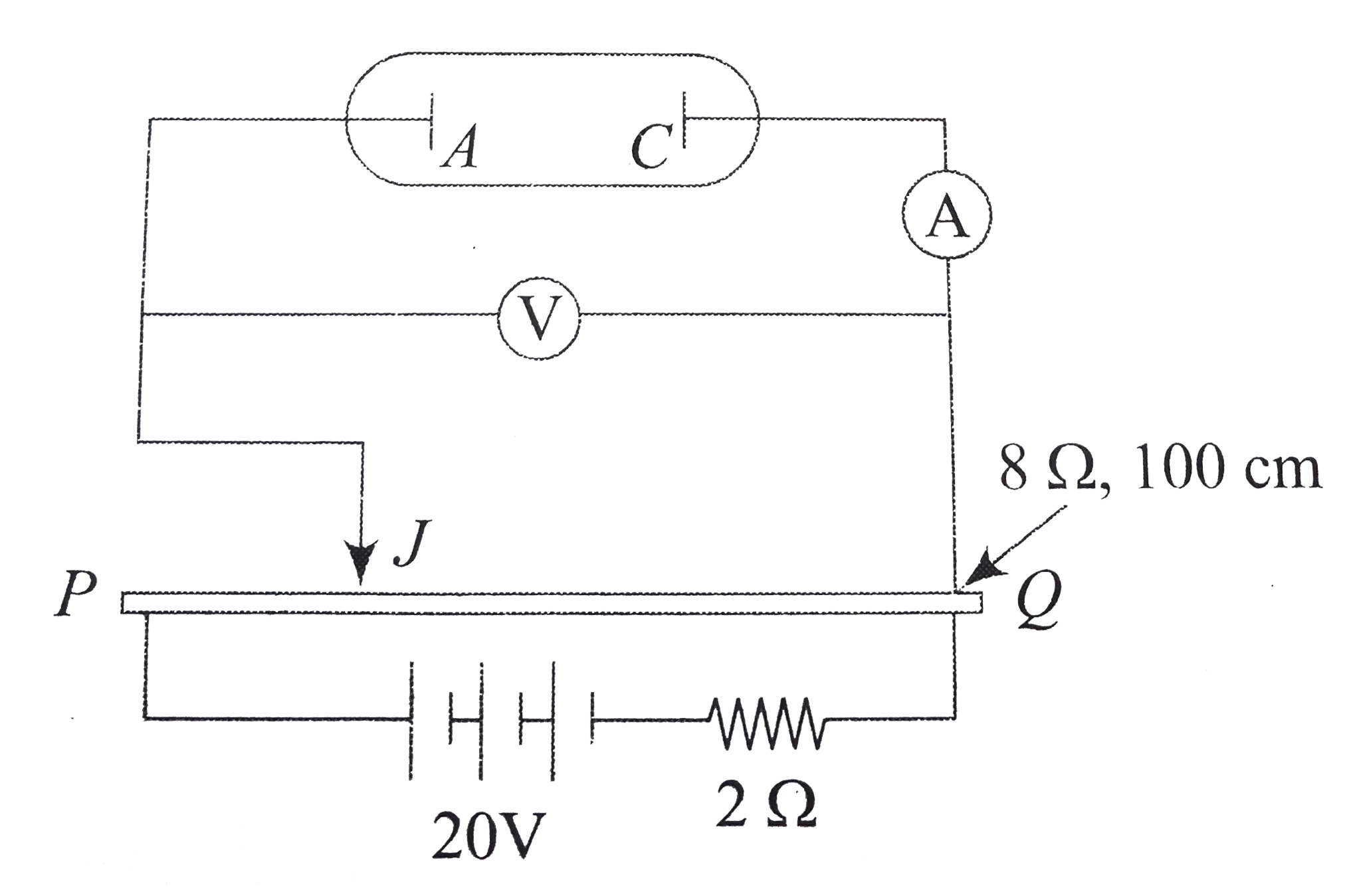
An experimental setup of verification of photoelectric effect is shown if Fig. The voltage across the electrodes is measured with the help of an ideal voltmeter, and which can be varied by moving jockey J on the potentiometer with wire. The battery used in potentiometer circuit is of 20 V and its internal resistance is 2Ω. The resistance of 100 cm long potentiometer wire is 8Ω.
The photocurrent is measured with the help of an ideal ammeter. Two plates of potassium oxide of area 50cm2 at separation 0.5mm are used in the vacuum tube. Photocurrent in the circuit is very small, so we can treat the potentiometer circuit as an independent circuit. The wavelength of various colors is as follows:
Q. Calculate the number of electrons that appear on the surface of the cathode plate, when the jockey is connected at the end P of the potentiometer wire. Assume that no radiation is falling on the plates.View SolutionQuestion 199

An experimental setup of verification of photoelectric effect is shown if Fig. The voltage across the electrodes is measured with the help of an ideal voltmeter, and which can be varied by moving jockey J on the potentiometer with wire. The battery used in potentiometer circuit is of 20 V and its internal resistance is 2Ω. The resistance of 100 cm long potentiometer wire is 8Ω.
The photocurrent is measured with the help of an ideal ammeter. Two plates of potassium oxide of area 50cm2 at separation 0.5mm are used in the vacuum tube. Photocurrent in the circuit is very small, so we can treat the potentiometer circuit as an independent circuit. The wavelength of various colors is as follows:
Q. When radiation falls on the cathode plate, a current of 2μA is recorded in the ammeter. Assuming that the vacuum tube setup sollows Ohm's law, the equivalent resistance of vacuum tube operating in this case when jockey is at end P is View SolutionQuestion 200
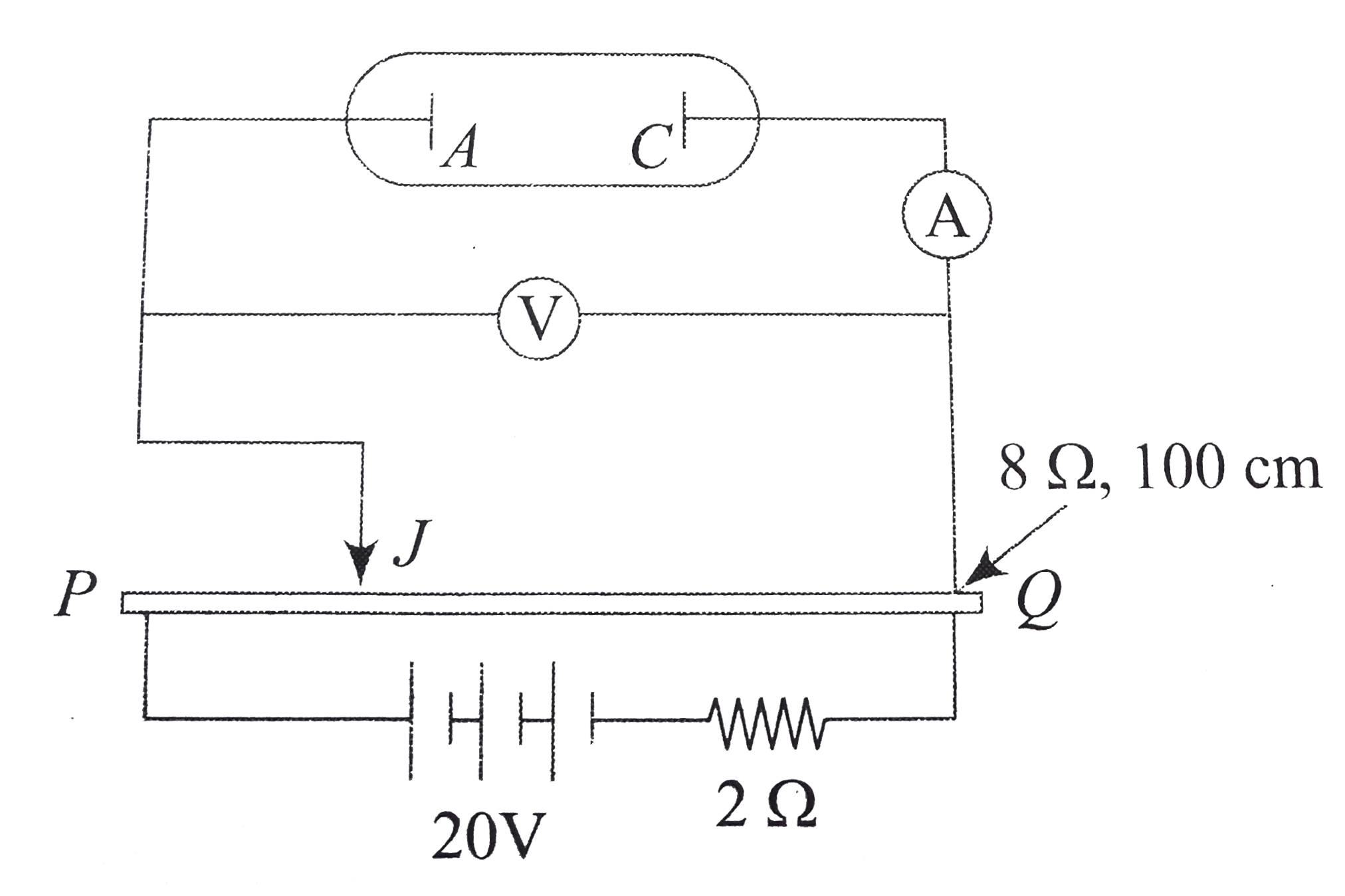
An experimental setup of verification of photoelectric effect is shown if Fig. The voltage across the electrodes is measured with the help of an ideal voltmeter, and which can be varied by moving jockey J on the potentiometer with wire. The battery used in potentiometer circuit is of 20 V and its internal resistance is 2Ω. The resistance of 100 cm long potentiometer wire is 8Ω.
The photocurrent is measured with the help of an ideal ammeter. Two plates of potassium oxide of area 50cm2 at separation 0.5mm are used in the vacuum tube. Photocurrent in the circuit is very small, so we can treat the potentiometer circuit as an independent circuit. The wavelength of various colors is as follows:
Q. It is found that ammeter current remains unchanged (2μA) even when the jockey is moved from the end P to the middle point of the potentiometer wire. Assuming that all the incident photons eject electrons and the power of the light incident is 4×10−6 W. Then, the color of the incident light is View SolutionQuestion 201
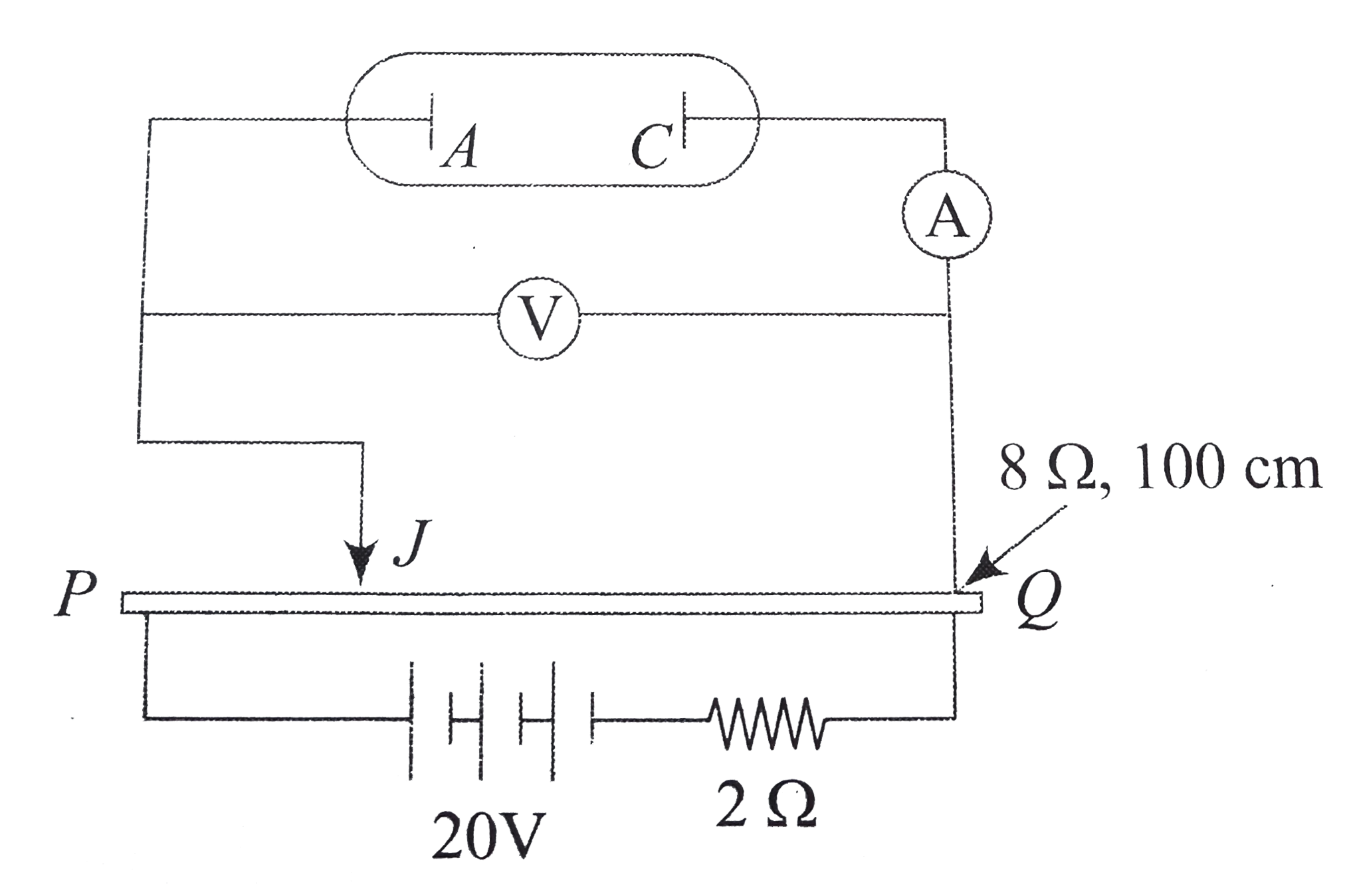
An experimental setup of verification of photoelectric effect is shown if Fig. The voltage across the electrodes is measured with the help of an ideal voltmeter, and which can be varied by moving jockey J on the potentiometer with wire. The battery used in potentiometer circuit is of 20 V and its internal resistance is 2Ω. The resistance of 100 cm long potentiometer wire is 8Ω.
The photocurrent is measured with the help of an ideal ammeter. Two plates of potassium oxide of area 50cm2 at separation 0.5mm are used in the vacuum tube. Photocurrent in the circuit is very small, so we can treat the potentiometer circuit as an independent circuit. The wavelength of various colors is as follows:
Q. Which of the following colors may not give photoelectric effect for this cathode? if power of incident light is 4*10^-6 and currenr 2micro ampere.View SolutionQuestion 202
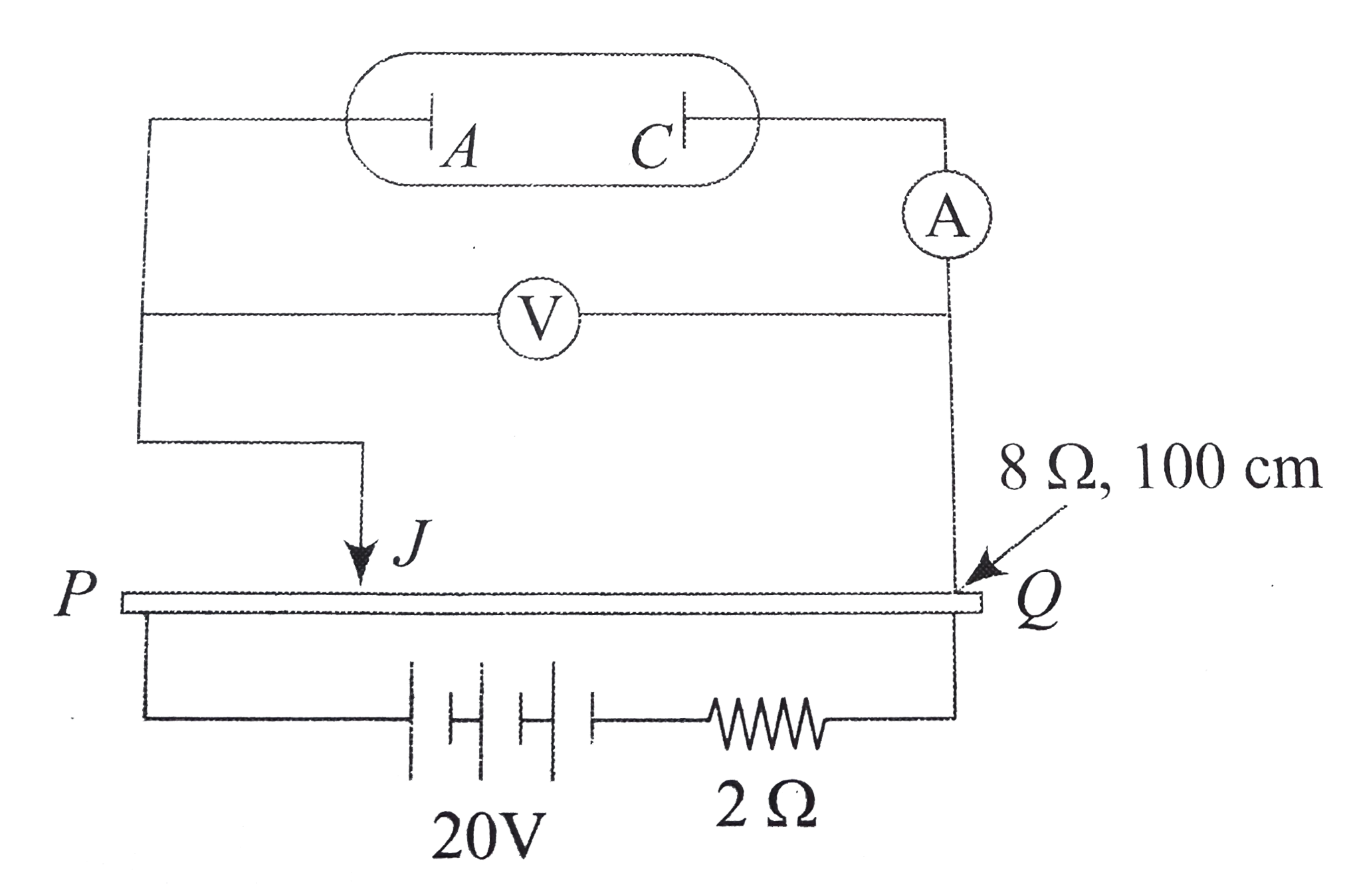
An experimental setup of verification of photoelectric effect is shown if Fig. The voltage across the electrodes is measured with the help of an ideal voltmeter, and which can be varied by moving jockey J on the potentiometer with wire. The battery used in potentiometer circuit is of 20 V and its internal resistance is 2Ω. The resistance of 100 cm long potentiometer wire is 8Ω.
The photocurrent is measured with the help of an ideal ammeter. Two plates of potassium oxide of area 50cm2 at separation 0.5mm are used in the vacuum tube. Photocurrent in the circuit is very small, so we can treat the potentiometer circuit as an independent circuit. The wavelength of various colors is as follows:
Q. When other light falls on the anode plate, the ammeter reading remains zero till jockey is moved from the end P to the middle point of the wire PQ. Thereafter, the deflection is recorded in the ammeter. The maximum kinetic energy of the emitted electron is View SolutionQuestion 203
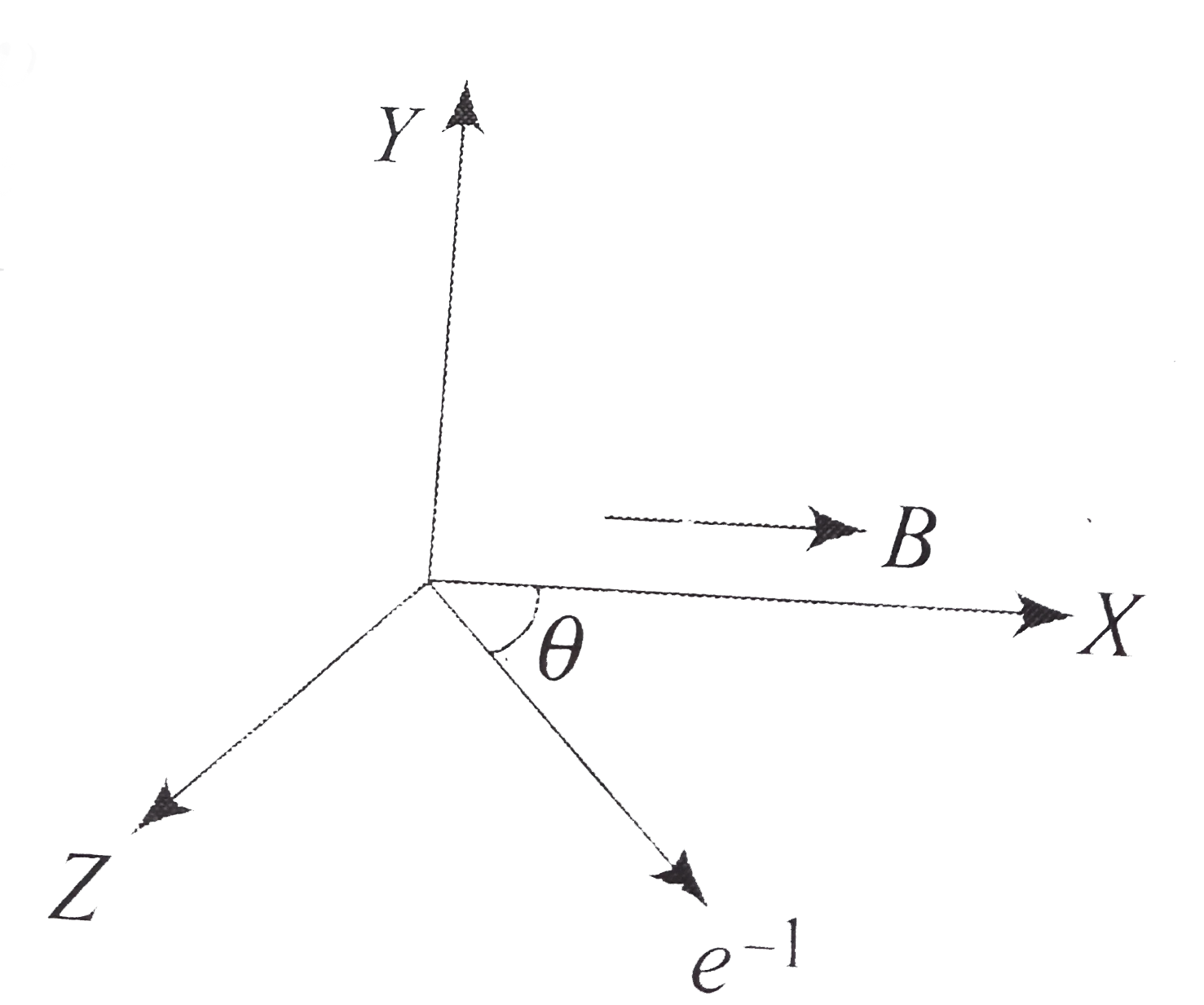
Light having photon energy hυ is incident on a metallic plate having work function ϕ to eject the electrons. The most energetic enectrons are then allowed to enter in a region of uniform magnetic field B as shown in Fig. The electrons are projected In X-Z plane making an angle θ with X-axis and magnetic field is →B=B0ˆi along X-axis maximum pitch of the helix described by an electron is found to be p. Take mass of electron as m and charge as q. Based on the above information, answer the following questions:
Q. The correct relation between p and B0 is View SolutionQuestion 204
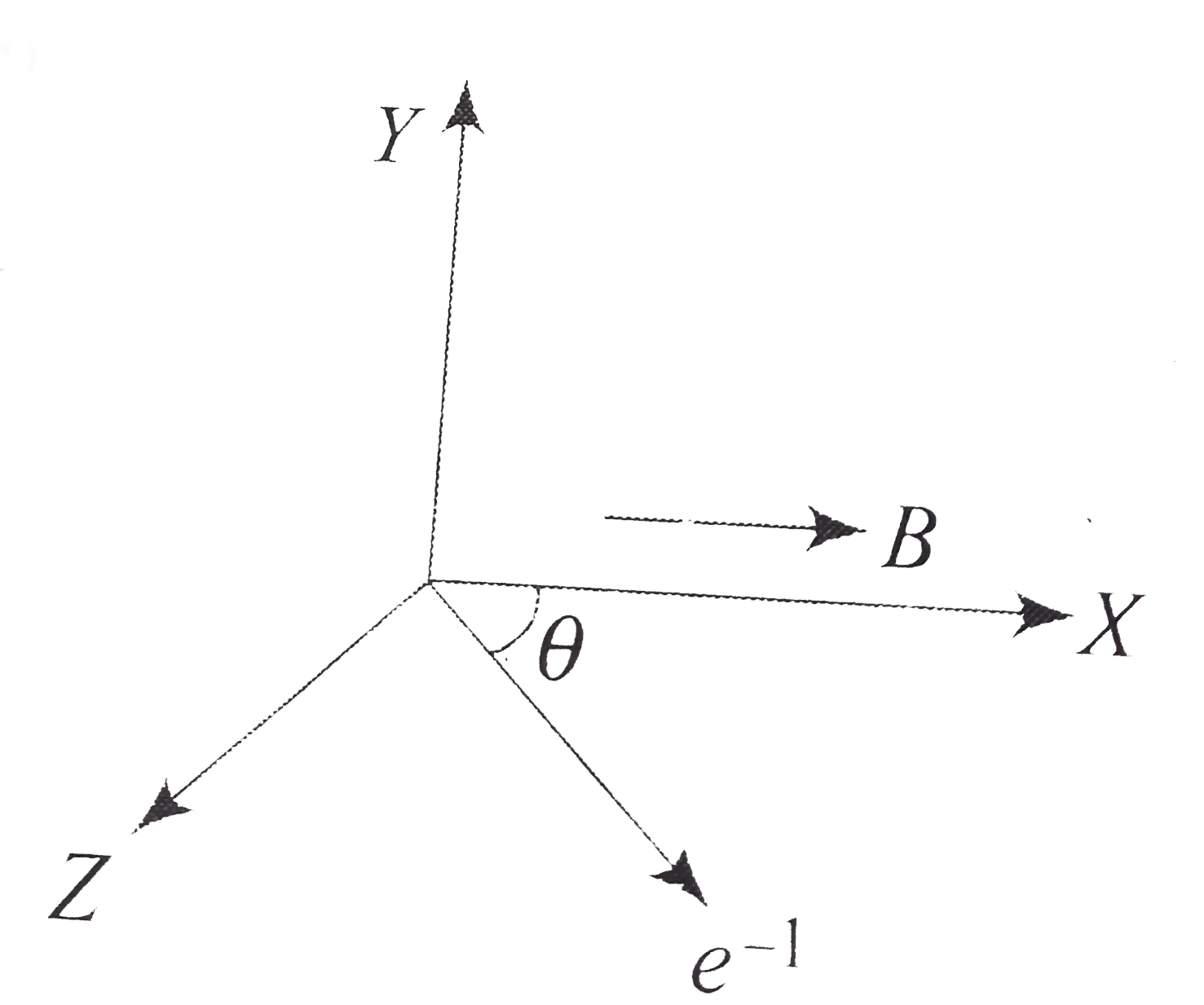
Light having photon energy hυ is incident on a metallic plate having work function ϕ to eject the electrons. The most energetic enectrons are then allowed to enter in a region of uniform magnetic field B as shown in Fig. The electrons are projected In X-Z plane making an angle θ with X-axis and magnetic field is →B=B0ˆi along X-axis maximum pitch of the helix described by an electron is found to be p. Take mass of electron as m and charge as q. Based on the above information, answer the following questions:
Q. Considering the instant of crossing origin at t=0 ,the Z-coordinate of the location of electron as a function of time isView SolutionQuestion 205

Light having photon energy hυ is incident on a metallic plate having work function ϕ to eject the electrons. The most energetic enectrons are then allowed to enter in a region of uniform magnetic field B as shown in Fig. The electrons are projected In X-Z plane making an angle θ with X-axis and magnetic field is →B=B0ˆi along X-axis maximum pitch of the helix described by an electron is found to be p. Take mass of electron as m and charge as q. Based on the above information, answer the following questions:
Q. The plot between X-coordinate of the location of electron as a function of time for different frequencies υ of the incident light isView SolutionQuestion 206
When light of sufficiently high frequency is incident on a metallic surface, electrons are emitted from the metallic surface. This phenomenon is called photoelectric emission. Kinetic energy of the emitted photoelectrons depends on the wavelength of incident light and is independent of the intensity of light. Number of emitted photoelectrons depends on intensity. (hv−ϕ) is the maximum kinetic energy of emitted photoelectron (where ϕ is the work function of metallic surface). Reverse effect of photo emission produces X-ray. X-ray is not deflected by electric and magnetic fields. Wavelength of a continuous X-ray depends on potential difference across the tuve. Wavelength of charasteristic X-ray depends on the atomic number.
Q. If frequency (υ>υ0) of incident light becomes n times the initial frequency (v), then KE of the emitted photoelectrons becomes (v0 threshold frequency).View SolutionQuestion 207
When light of sufficiently high frequency is incident on a metallic surface, electrons are emitted from the metallic surface. This phenomenon is called photoelectric emission. Kinetic energy of the emitted photoelectrons depends on the wavelength of incident light and is independent of the intensity of light. Number of emitted photoelectrons depends on intensity. (hv−ϕ) is the maximum kinetic energy of emitted photoelectron (where ϕ is the work function of metallic surface). Reverse effect of photo emission produces X-ray. X-ray is not deflected by electric and magnetic fields. Wavelength of a continuous X-ray depends on potential difference across the tuve. Wavelength of charasteristic X-ray depends on the atomic number.
Q. A monochromatic light is used in a photoelectric experiment on photoelectric effect. The stopping potentialView SolutionQuestion 208
When light of sufficiently high frequency is incident on a metallic surface, electrons are emitted from the metallic surface. This phenomenon is called photoelectric emission. Kinetic energy of the emitted photoelectrons depends on the wavelength of incident light and is independent of the intensity of light. Number of emitted photoelectrons depends on intensity. (hv−ϕ) is the maximum kinetic energy of emitted photoelectron (where ϕ is the work function of metallic surface). Reverse effect of photo emission produces X-ray. X-ray is not deflected by electric and magnetic fields. Wavelength of a continuous X-ray depends on potential difference across the tuve. Wavelength of charasteristic X-ray depends on the atomic number.
Q. If potential difference across the tube is increased thenView SolutionQuestion 212
When a high frequency electromagnetic radiation is incident on a metallic surface, electrons are emitted from the surface. Energy of emitted photoelectrons depends only on the frequency of incident electromagnetic radiation and the number of emitted electrons depends only on the intensity of incident light.
Einstein's protoelectron equation [Kmax=hv−ϕ} correctly explains the PE, where υ= frequency of incident light and ϕ= work function.
Q. The slope of the graph between stopping potential and frequency is [here h is the Planck's constant and e is the charge of an electron] is View SolutionQuestion 213
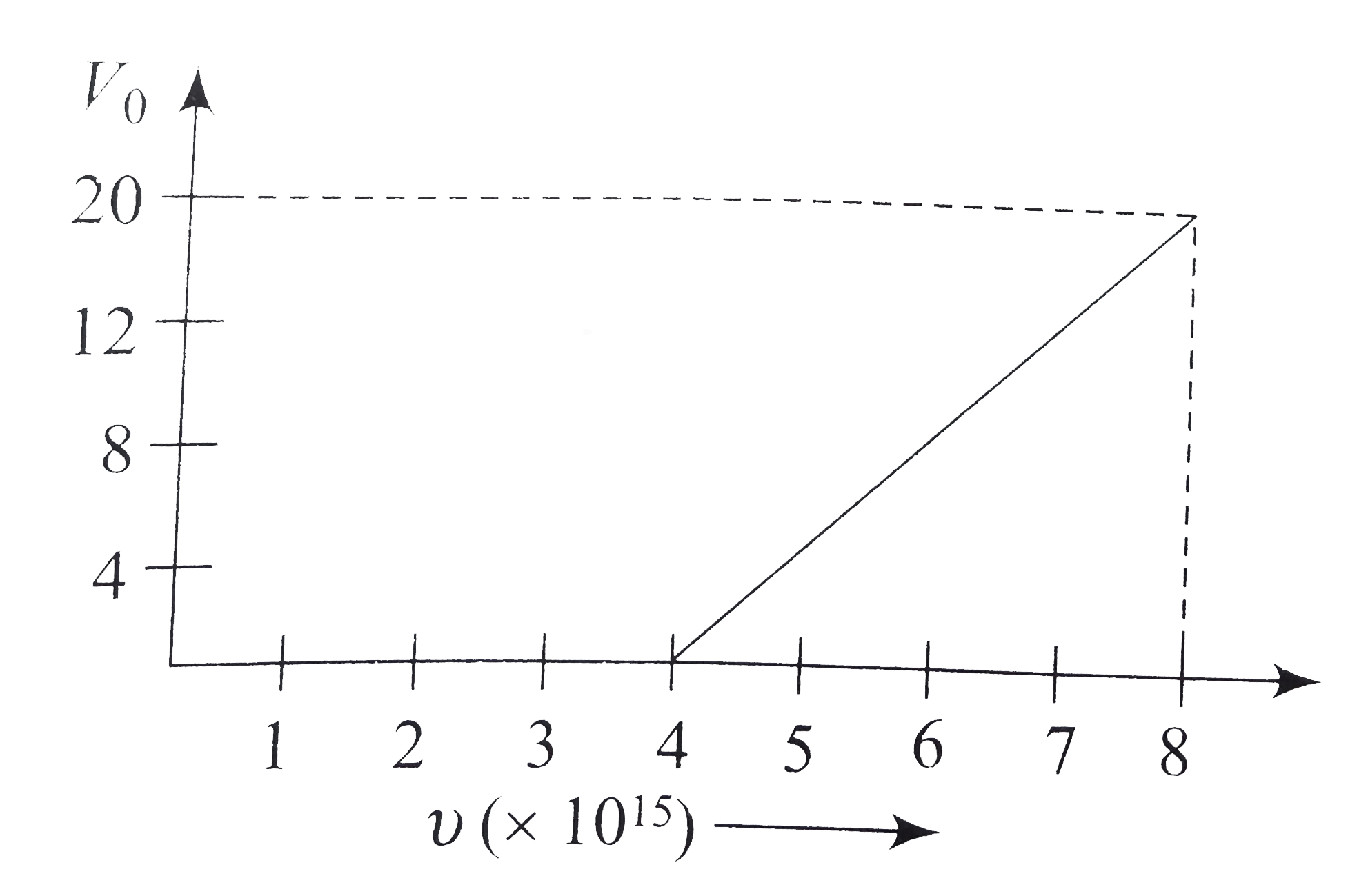
When a high frequency electromagnetic radiation is incident on a metallic surface, electrons are emitted from the surface. Energy of emitted photoelectrons depends only on the frequency of incident electromagnetic radiation and the number of emitted electrons depends only on the intensity of incident light.
Einstein's protoelectron equation [Kmax=hv−ϕ] correctly ecplains the PE, where υ= frequency of incident light and ϕ= work function.
Q. For photoelectric effect in a metal, the graph of the stopping potential V0 (in volt) versus frequency υ (in hertz) of the incident radiation is shown in Fig. The work function of the metal (in eV) is.View SolutionQuestion 214
When a high frequency electromagnetic radiation is incident on a metallic surface, electrons are emitted from the surface. Energy of emitted photoelectrons depends only on the frequency of incident electromagnetic radiation and the number of emitted electrons depends only on the intensity of incident light.
Einstein's protoelectron equation [Kmax=hv−ϕ} correctly explains the PE, where υ= frequency of incident light and ϕ= work function.
Q. The slope of the graph between stopping potential and frequency is [here h is the Planck's constant and e is the charge of an electron] is View SolutionQuestion 215
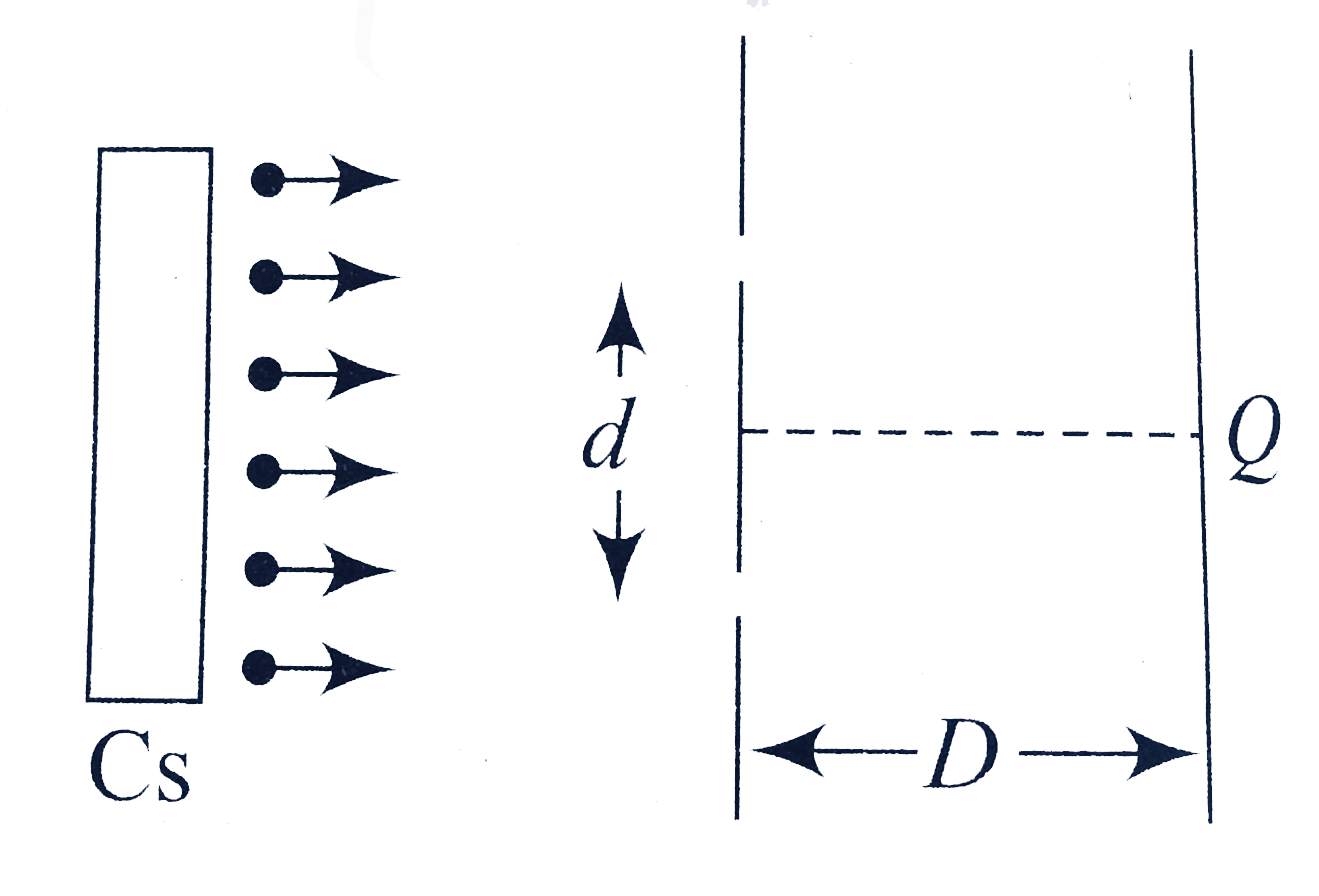
A Cs plate is irradiated with a light of wavelength λ=hcϕ,ϕ being the work function of the plate, h Plank's constant, and c the velocity of light in vacuum. Assume all the photoelectron are moving perpendicular to the plate toward a YDSE setup when accelerated through a potential difference V. Take charge on a proton =e and moss of an electron =m. Read the paragraph carefully and answer the following question:The fringe width due to the electron beam is View SolutionQuestion 216
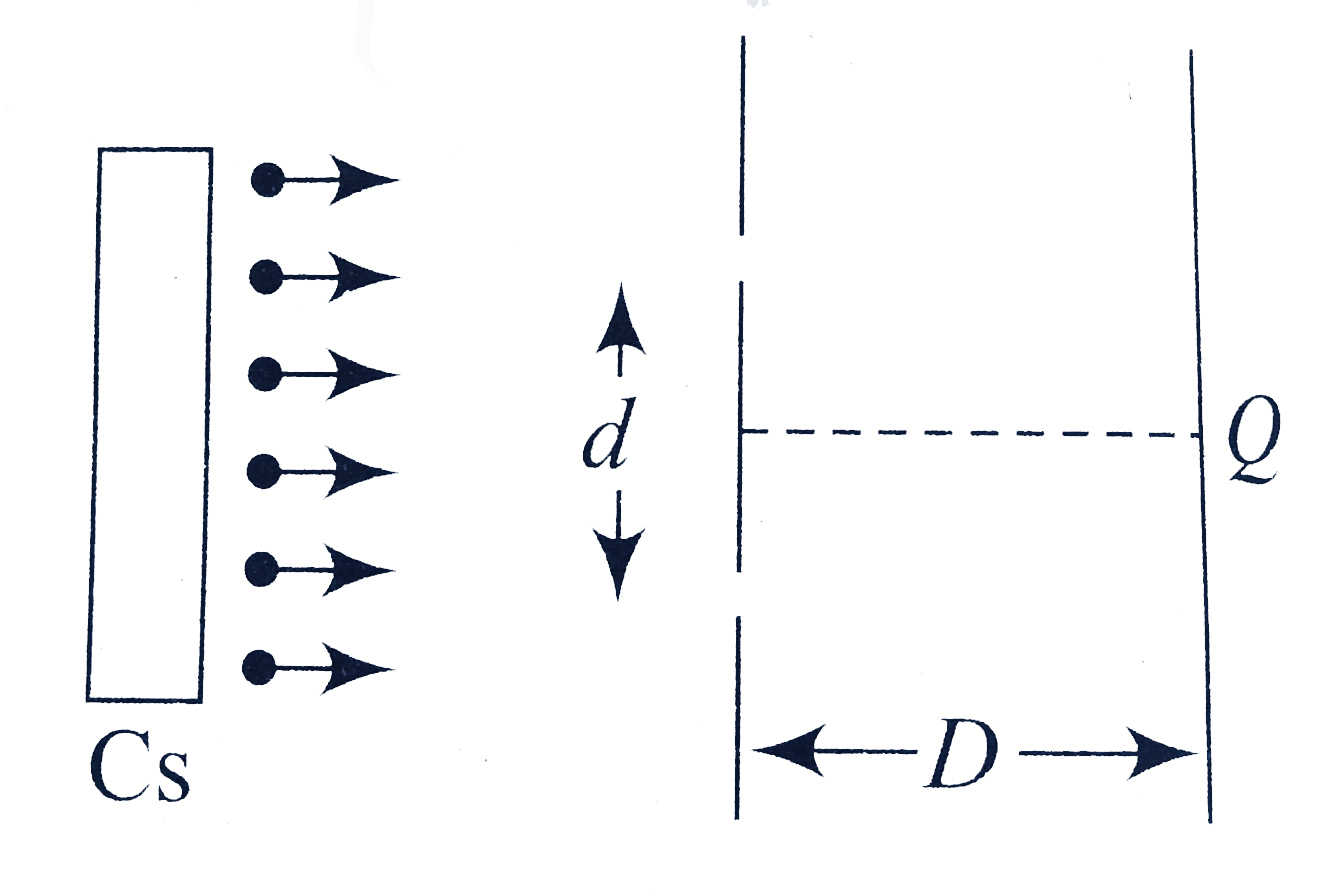
A Cs plate is irradiated with a light of wavelength λ=hcϕ,ϕ being the work function of the plate, h Plank's constant, and c the velocity of light in vacuum. Assume all the photoelectron are moving perpendicular to the plate toward a YDSE setup when accelerated through a potential difference V. Take charge on a proton =e and moss of an electron =m. Read the paragraph carefully and answer the following question:
Q. If the wavelength of light used in photoemission is less that λ, then the fringe width willView SolutionQuestion 217

A Cs plate is irradiated with a light of wavelength λ=hcϕ,ϕ being the work function of the plate, h Plank's constant, and c the velocity of light in vacuum. Assume all the photoelectron are moving perpendicular to the plate toward a YDSE setup when accelerated through a potential difference V. Take charge on a proton =e and moss of an electron =m. Read the paragraph carefully and answer the following question:The fringe width due to the electron beam is View SolutionQuestion 218
A pushed dye laser emits light of wavelength 585 nm. Because this wavelength is strongly absorbed by the haemoglobin in the blood, the method is especially effective for removing various types of blemishes due to blood. To get a reasonable estimate of the power required for such laser surgery, we can model the blood as having the same specific heat and heat of vaporization as water. [S=4.2×103J(kgK)−1,L=2.25×106Jkg]
Q. Suppose that each pulse must remove 2μg of blood by evaporating it starting at 30∘C. The energy that each pulse must deliver to the blemish is nearlyView SolutionQuestion 219
A pushed dye laser emits light of wavelength 585 nm. Because this wavelength is strongly absorbed by the haemoglobin in the blood, the method is especially effective for removing various types of blemishes due to blood. To get a reasonable estimate of the power required for such laser surgery, we can model the blood as having the same specific heat and geat of vaporization as water. [S=4.2×103J(kgK)−1,L=2.25×106Jkg]
Q. Suppose that each pulse must remove 2μg of blood by evaporating it starting at 30∘C.The power output of laser in time 450μs must beView SolutionQuestion 220
A pushed dye laser emits light of wavelength 585 nm. Because this wavelength is strongly absorbed by the haemoglobin in the blood, the method is especially effective for removing various types of blemishes due to blood. To get a reasonable estimate of the power required for such laser surgery, we can model the blood as having the same specific heat and geat of vaporization as water. [S=4.2×103J(kgK)−1,L=2.25×106Jkg]
Q. Suppose that each pulse must remove 2μg of blood by evaporating it starting at 30∘C.The number of photons that each pulse delivers to the blemish is View SolutionQuestion 226
A totally reflecting, small plane mirror placed horizontally faces a parallel beam of lighy as shown in figure. The mass of the mirror is 20g. Assume that there is no absorption in the lens and that 30% of the light emitted by the source goes through the lens. Find the power of the source needed to support the weight of the mirror. Take g=10ms−2.
 View Solution
View SolutionQuestion 227
A silver ball of radius 4.8 cm is suspended by a thread in a vacuum chamber, Ultraviolet light of wavelength 200nm is incident on the ball for some time during which a total light energy of 1.0×10−7 J falls on the surface. Assuming that on the average one photon out of every ten thousand is able to eject a photoelectron, find the electric potential at the surface of the ball assuming zero potential at infinity. What is the potential at the centre of the ball?View SolutionQuestion 242
When a monochromatic point source of light is at a distance
of 0.2 m from a photoelectric cell, the cut off voltage and the saturation current
are respectively 0.6 V and 18.0 mA. If the same source is placed 0.6 m away
from the photoelectric cell, then
(a) the stopping potential will be 0.2 V
(b) the stopping potential will be 0.6 V
(c ) the saturation current will be 6.0 mA
(d) the saturation current will be 2.0 mA
View SolutionQuestion 243
When photons of energy 4.25eV strike the surface of metal A, the ejected photoelectrons have maximum kinetic energy TA eV and De-broglie wavelength λA. The maximum energy of photoelectron liberated from another metal B by photon of energy 4.70 eV is TB=(TA−1.50)eV if the de Brogle wavelength of these photoelectrons is λB=2λA, then View SolutionQuestion 244
The graph between 1/λ and stopping potential (V) of three metals having work- functions Φ1, Φ2 and Φ3 in an experiment of photoelectric effect is plotted as shown in the figure. Which of the following statement(s) is/are correct? (Here, λ is the wavelength of the incident ray).
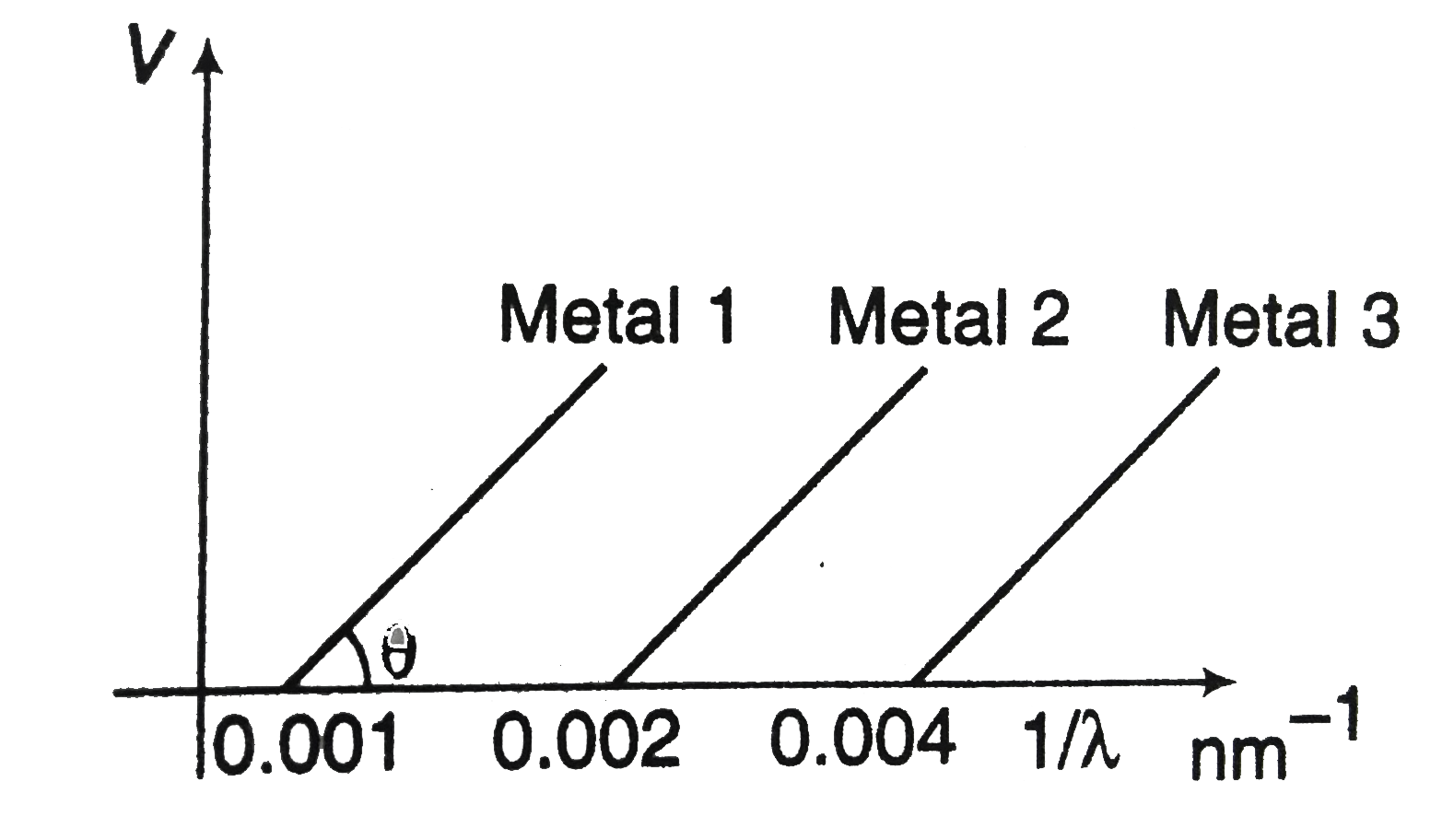 View Solution
View SolutionQuestion 247
When a particle is restricted to move along x-axis between x=0 and x=a, where α if of nenometer dimension, its energy can take only certain specific values. The allowed energies of the particle moving in such a restricted region, correspond to the formation of standing waves with nodes at its ends x=0 and x=a. The wavelength of this standing wave is related to the linear momentum p of the particle according to the de Broglie relation. The energy of the particle of mass m is related to its linear momentum as E=p22m. Thus the energy of the particle can be denoted by a quantum number n taking values 1,2,3, ...(n=1, called the ground state) corresponding to the number of loops in the standing wave.
Use the model described above to answer the following three questions for a particle moving along the line from x=0 to x=α. Take h=6.6×10−34Js and e=1.6×10−19 C.
Q. The allowed energy for the particle for a particular value of n is proportional to View SolutionQuestion 248
When a particle is restricted to move along x-axis between x=0 and x=a, where α if of nenometer dimension, its energy can take only certain specific values. The allowed energies of the particle moving in such a restricted region, correspond to the formation of standing waves with nodes at its ends x=0 and x=a. The wavelength of this standing wave is related to the linear momentum p of the particle according to the de Broglie relation. The energy of the particle of mass m is related to its linear momentum as E=p22m. Thus the energy of the particle can be denoted by a quantum number n taking values 1,2,3, ...(n=1, called the ground state) corresponding to the number of loops in the standing wave.
Use the model described above to answer the following three questions for a particle moving along the line from x=0 to x=α. Take h=6.6×10−34Js and e=1.6×10−19 C.
Q. If the mass of the particle is m=1.0×10−30kg and α=6.6nm, the energy of the particle in its ground state is closest to View SolutionQuestion 249
When a particle is restricted to move along x-axis between x=0 and x=a, where α if of nenometer dimension, its energy can take only certain specific values. The allowed energies of the particle moving in such a restricted region, correspond to the formation of standing waves with nodes at its ends x=0 and x=a. The wavelength of this standing wave is related to the linear momentum p of the particle according to the de Broglie relation. The energy of the particle of mass m is related to its linear momentum as E=p22m. Thus the energy of the particle can be denoted by a quantum number n taking values 1,2,3, ...(n=1, called the ground state) corresponding to the number of loops in the standing wave.
Use the model described above to answer the following three questions for a particle moving along the line from x=0 to x=α. Take h=6.6×10−34Js and e=1.6×10−19C
Q. The speed of the particle that can take discrete values is proportional to View SolutionQuestion 251
A silver sphere of radius 1 cm and work function 4.7 eV is suspended from an insulating thread in free-space. It is under continuos illumination of 200 jnm jwavelength light. As photoelectrons are emitted, the sphere gets charged and acquires a potential. The maximum number of photoelectrons emitted from the sphere is A×10z(where1<A<10). the value of Z is View SolutionQuestion 252
A proton is fired from very far away towards a nucleus with charge Q = 120 e, where e is the electronic charge. It makes a closest approach of 10fm to the nucleus. The de - Broglie wavelength (in units of fm) of the proton at its start is take the proton mass, mp=5/3×10−27kg,h/e=4.2×10−15J−s/C, 14πε0=9×109m/F,1fm=10−15. View Solution

